Introduction
This report presents the main results of the 21st round of the Survey on the Access to Finance of Enterprises (SAFE), which was conducted between 16 September and 25 October 2019. The survey covers the period from April to September 2019. The total euro area sample size was 11,204 enterprises, of which 10,241 (91%) had fewer than 250 employees.[1]
The report provides evidence on changes in the financial situation of enterprises and documents trends in the need for and availability of external financing. It includes results on small- and medium-sized enterprises (SMEs) as well as large firms and examines developments both at the euro area level and in individual countries.
1 Overview of the results
Availability of skilled labour remained the dominant concern for euro area SMEs, together with the difficulty of finding customers, while access to finance was considered the least important obstacle. As in previous editions, the 21st round of the Survey on the Access to Finance of Enterprises (SAFE) asked entrepreneurs to indicate the most pressing problem facing their company. Availability of skilled labour was considered the main problem for euro area SMEs (28%), together with the difficulty of finding customers (22%). Access to finance, on the other hand, remained the least important obstacle (7%), after cost of production, regulation and competition (all mostly unchanged at 12%). SMEs in Greece continued to be strongly affected by the lack of access to finance, with one quarter mentioning it as their most important problem. At 9%, Italy had the second largest share of SMEs reporting access to finance as their dominant concern.
Euro area SMEs’ turnover remained broadly stable at robust levels. However, for the first time since mid-2016, they reported a deterioration in profits. In particular, a net[2] 20% of euro area SMEs reported higher turnover (from 21%). At the same time, however, they reported declining profits (-1%, from 0%), but with significant differences across countries.
Changes in profits may reflect somewhat weak margins, attributable in part to competition and rising labour and other costs. The net percentage of SMEs indicating an increase in labour costs reached 50% (from 52%), while the net percentage of firms reporting an increase in other costs declined to 53% from 57%. In this round, a smaller net percentage of SMEs reported an increase in interest expenses (1%, from 5%), while continuing to signal declining leverage (-7%, unchanged). The subdued economic growth was reflected in investment and hiring decisions. In net terms, 16% of SMEs reported increases in fixed investments (from 18%), 7% in inventories and working capital and 12% in the number of employees (both unchanged from the previous survey round).
The external financing gap of SMEs – the difference between the change in demand for and the change in the availability of external financing – remained negative[3] at the euro area level (-4%, from -3%) and in most euro area countries (see Table A, column 10).
For the first time since 2009, demand for bank loans decreased over the period under review. In net terms, euro area SMEs reported a decline in needs for bank loans (-1%, from 3%) and smaller increases for credit lines (4%, from 6%) (see Table A, columns 2 and 4 respectively). About 7% of SMEs, on balance, reported an increased need for trade credit (from 9%), and 11% indicated a higher demand for leasing or hire-purchase (unchanged). Financing from external and internal sources was mainly used for fixed investment and for inventories and working capital. Moreover, SMEs used finance to hire and train new employees and develop and launch new products.
SMEs continued to indicate improvements in the availability of external sources of finance. The net percentage of SMEs reporting an improvement in the availability of bank loans increased to 10% (from 9%) (see Table A, column 6). The countries in which SMEs reported the most improvement in the availability of bank loans were Greece and Portugal.
Latest developments in SAFE country results for SMEs
(over the preceding six months; net percentages of respondents)
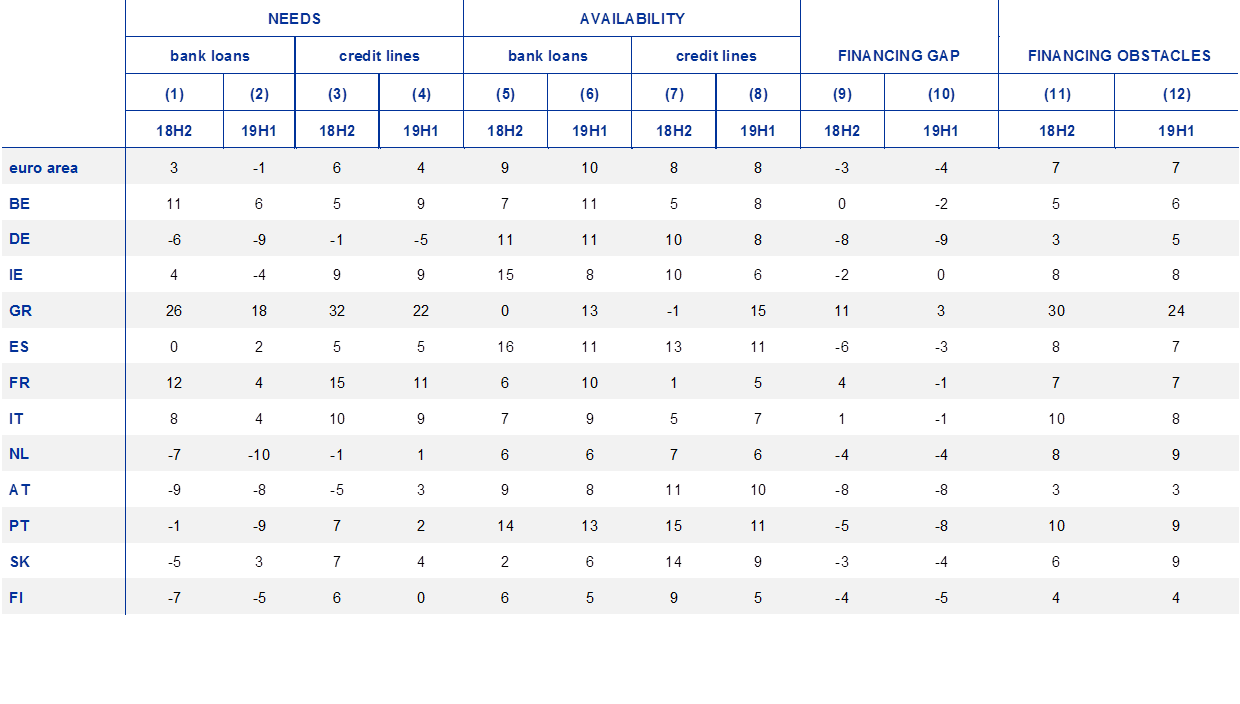
Note: for “needs”, see Chart 11; for “availability”, see Chart 15; and for the “financing gap”, see the notes to Chart 17. For “financing obstacles”, see the notes to Chart 20. “18H2” refers to round twenty (October 2018 to March 2019) and “19H1” refers to round twenty-one (April to September 2019).
The growing macroeconomic uncertainty was reflected in the replies of SMEs on the impact of various factors on the availability of external finance. In fact, changes in the macroeconomic outlook were perceived to have negatively affected the access to finance for SMEs (-13%, from -9%) and the deterioration was widespread across countries. At the same time, SMEs continued to indicate an improvement in the willingness of banks to provide credit (a net 14%, from 16%), as well as in their firm-specific outlook (5%), capital position (18%) and credit history (17%).The overall indicator of financing obstacles[4] for bank loans for SMEs remained unchanged at 7% (see Table A, column 12). While the percentages of SMEs reporting difficulty in accessing bank loans diminished in most countries, financing obstacles remained relatively significant in the Netherlands, Portugal, Slovakia (all 9%) and Greece (24%). In this survey round, 26% of SMEs had applied for a loan. The rate for fully successful loan applications was 72% (from 73%), while the rejection rate remained unchanged at 6%.
Regarding price terms and conditions of bank financing, SMEs reported, on balance, declines in bank interest rates (-9%, from 4%). At the same time, 29% of SMEs (from 30%) continued to signal higher levels of other costs of financing, such as charges, fees and commissions. As for non-price terms and conditions, SMEs reported, on balance, increases in the available size (12%) and maturity (2%), but also increases in collateral requirements (12%), all of which were broadly unchanged from the previous survey round.
The financial situation of large enterprises remained better than that of SMEs, and they continued to report increases in both turnover and profits, although with a strong degree of moderation relative to the previous survey rounds. Around 39% of large firms applied for a bank loan, with a success rate that was much higher (87%) and a rejection rate that was much lower (1%) than those of SMEs. According to the survey results, the average interest rate charged to large enterprises on credit lines was about 170 basis points lower than that paid by SMEs. Overall, large firms therefore continued to benefit from better access to finance than SMEs.
Nevertheless, in this survey round, large and medium-sized enterprises conveyed a more negative view of the business environment influencing their access to external funds than SMEs. 18% of large enterprises and 13% of medium-sized ones reported that the general economic outlook might have become an impediment for their access to external finance (from -6% and –4%, respectively).
This survey round included two groups of ad hoc questions aimed at featuring SMEs’ main export markets and the impact of late payments. Regarding external markets, the survey responses confirm that non-domestic sales are important for euro area SMEs: 38% of SMEs exported some goods or services in 2018, with the majority of them targeting the euro area. In addition, a significant percentage of SMEs exported outside Europe, particularly to North America and Asia.
As for late payments, 13% of SMEs indicated that they experienced problems on a regular basis owing to late payments from private or public entities, while 30% mentioned that these problems had occurred (occasionally) in the last six months. As a consequence, most suppliers were negatively affected, but SMEs also signalled changes in their investment and production plans as a result.
In short, the survey results are consistent with expectations of subdued growth despite accommodative financing conditions. As a reflection of a deterioration in the general economic outlook, SMEs reported some growing concerns about developments in their business environment which they perceived as an impediment to their access to external finance.
2 The financial situation of SMEs in the euro area
2.1 Smaller improvements in the financial situation of euro area SMEs
In the period from April to September 2019, the financial situation of euro area SMEs remained consistent with expectations of subdued growth despite accommodative financing conditions (see Chart 1).
Change in the income and debt situation of euro area enterprises
(over the preceding six months; net percentages of respondents)
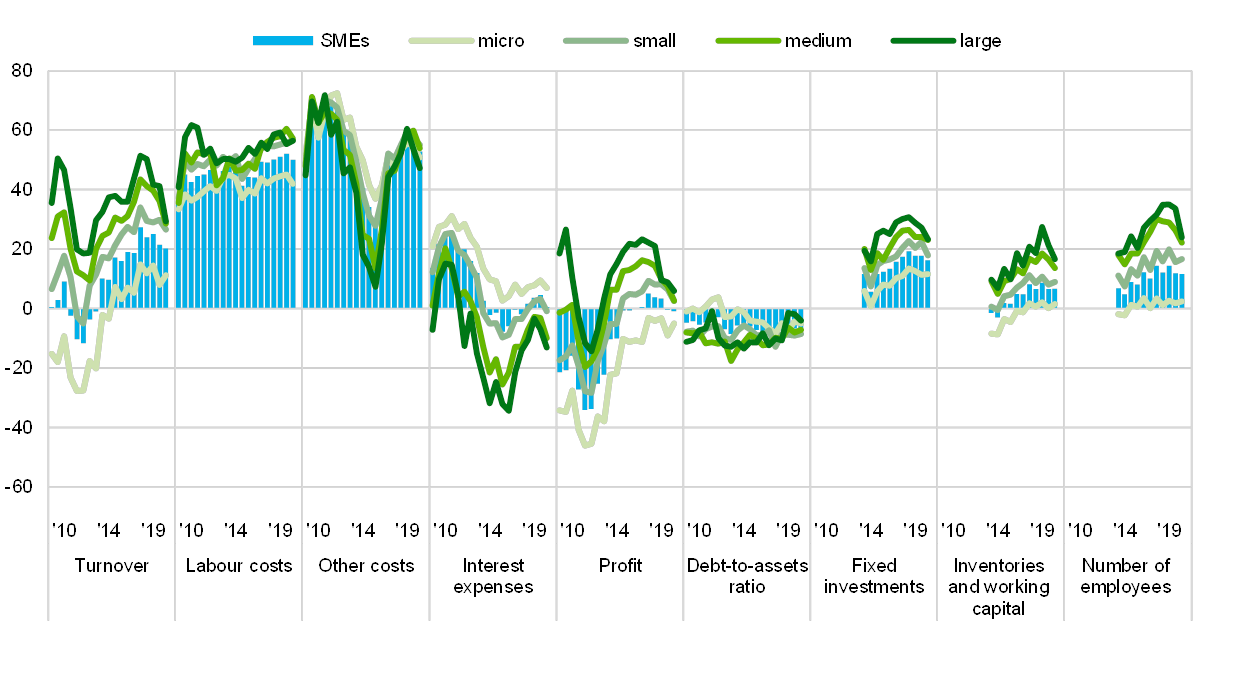
Base: All enterprises. Figures refer to rounds 3 (March-September 2010) to 21 (April-September 2019) of the survey.Notes: The net percentage is the difference between the percentage of enterprises reporting an increase for a given factor and the percentage reporting a decrease. From round 11 onwards (April-September 2014), the concept of “Net interest expenses (what you pay in interest for your debt minus what you receive in interest for your assets)” was replaced with “Interest expenses (what your company pays in interest for its debt)”.
Q2. Have the following company indicators decreased, remained unchanged or increased over the past six months?
Euro area SMEs’ turnover remained broadly stable at robust levels. The net percentage[5] of euro area SMEs[6] reporting higher turnover declined slightly to 20% (from 21% during the previous survey period[7]). In net percentage terms, larger firms continued to report a higher turnover, but also experienced bigger declines compared to the previous round. The corresponding share of large firms was 29% (down from 41%), while it was 29% for medium-sized firms (down from 36%) and 27% for small (down from 30%). By contrast, micro SMEs reported on balance an improvement in turnover of 11% (up from 8%).
Euro area enterprises continued to report, on balance, rising labour and other costs amid slight improvements in their debt and investment decisions. A high net proportion of euro area SMEs across all size categories continued to report rising labour costs (50% overall, down slightly from 52%) with responses broadly unchanged relative to the previous survey round: 42% (down from 45%) for micro, 57% (from 56%) for small, 57% (from 60%) for medium and 56% (from 55%) for large firms. As regards net increases in other costs, survey results point to a slight moderation across all firm sizes: large firms (47%, from 54%) and SMEs (53% from 57%).
Profits also reflected the rise in costs, as, in net terms, SMEs reported decreasing profits (-1%) for the first time since 2009 (from 0% in the last round). While micro firms continued to report declining profits (-5%, from -9%), lower net percentages of larger firms reported profit increases, at 6% (down from 9%) for large firms, 3% (down from 8%) for medium-sized firms and 3% (down from 7%) for small firms.
Deleveraging among euro area enterprises seems to have stabilised since the previous survey round. The net percentage of SMEs indicating a decline in their debt-to-asset ratio was unchanged at -7%, with a slightly higher share among micro (-5%, from -4%) and large firms (-4%, from -2%), but slightly lower for small (-8% from -9%) and medium-sized firms (-7%, from -8%).
For the first time since the last four rounds, the net percentage of SMEs in this survey round reporting higher interest expenses declined (1%, from 5%). However, there was some heterogeneity with regard to firm size. For micro enterprises the net balance of reporting higher interest costs declined to 7% (from 9%). In contrast, small (-1% from 3), medium (-10 from -3%) and larger enterprises (-13% from -7%) continued to report reductions in interest expenses.
The softening economic growth was reflected in investment and hiring decisions. On balance, euro area SMEs continued to report rising fixed investments (16%, down from 18%), increasing inventories and working capital (7%, unchanged) and a growing number of employees (12%, unchanged). These dynamics applied to firms in all size categories, but the decline in net percentages for large firms was higher than for SMEs in these three areas.
The improvements in turnover softened somewhat, but were widespread across countries. Among the large euro area countries (see Chart 2), the net percentage of SMEs indicating higher turnover was largest in Germany (25%, from 29%), and France (25%, from 20%) followed by Spain (15%, from 20%), and Italy (7%, from 6%). SMEs also reported higher turnover in the other euro area countries, particularly in the Netherlands, Belgium, Ireland and Austria, but also in Greece, where the net percentage of SMEs reporting increased turnover remained in double digits for a third consecutive survey round (18%, from 10%) since the beginning of the crisis (see Chart 1a in Annex 1).
Change in the income and debt situation of euro area SMEs
(over the preceding six months; net percentages of respondents)

Base: All SMEs. Figures refer to rounds 3 (March-September 2010) to 21 (April-September 2019) of the survey.Note: See the notes to Chart 1.
Q2. Have the following company indicators decreased, remained unchanged or increased over the past six months?
Profit dynamics continued to vary greatly from country to country. Among the large euro area countries, a lower but still positive net percentage of SMEs reported increasing profits in Germany (5%, from 9%), while there was no change among French SMEs (0%, from -4%), with Italian (-16%, unchanged) and Spanish SMEs (-7% from -4%) continuing to report, in net terms, decreasing profits. SMEs in Slovakia, and, in particular, Greece (-15%, from -30%) also continued to report net decreases in profits. While positive in all other euro area countries the net percentages of SMEs reporting increased profits mostly shrunk, with only Belgium and Finland recording an increase (see Chart 1a in Annex 1).
Across countries, euro area enterprises continued to deleverage. Among the large countries, on balance, SMEs in Germany (-9%, unchanged), France (-9%, from -6%) and Spain (-5%, from -6%) reported a reduction in the debt-to-asset ratio, while those in Italy reported a rise (1%, unchanged). SMEs in all other euro area economies also reported, on balance, lower debt-to-asset ratios (see Chart 2a in Annex 1).
In this survey round euro area SMEs, on balance, indicated an increase in interest expenses, although country-specific developments differed. Among the large economies, the highest net percentages were recorded among Spanish (10%, from 9%), Italian (9%, from 14%), and French SMEs (7%, from 13%), while German SMEs continued to report decreasing interest expenditures (-11%, from -6%). Among the other countries, only SMEs in the Netherlands (-10%, down from -4%), Belgium (-7%, from +4%), Austria (-9%, from -4%) and Finland (-4%, from 1%) reported, on balance, lower interest expenditures, while Ireland had the highest net percentage of SMEs reporting an increase in interest expenses (12%, down from 20%).
An increase in labour and other costs (for material and energy) was visible across all countries. The net percentage of SMEs reporting an increase in labour costs was highest in Slovakia (65%, from 68%) and lowest in France (38%, from 34%). For other costs, the corresponding net percentage was highest in Ireland (58%, from 66%) and France (58%, from 64%) and lowest in Austria and the Netherlands (both 44% and 42%, from 50% and 52% respectively) and Greece (40%, from 45%).
On balance, SMEs in all countries reported more moderate increases in fixed investment, inventories and working capital, and employment. Among the large euro area countries, a slightly lower net proportion of SMEs in Germany, Spain and Italy continued to report an increase in fixed investment (13%, 21% and 17% respectively, compared with 17%, 23% and 18% in the previous survey round), and a slightly higher proportion in France (15%, from 13%). Among the other euro area countries, the net percentage of SMEs reporting an increase in fixed investment was highest in Ireland (20%), Slovakia (21%) and Portugal (25%). In net terms, inventories and working capital also continued to increase in most countries. SMEs in Germany reported a lower net percentage increase, while they were unchanged for those in Italy and Spain, and higher for those in France. In the other countries, only Greek SMEs continued to report declining inventories and working capital (-6%, from -13%).
Regarding employment in the large euro area countries, the net percentage of SMEs reporting an increase in the number of employees was highest in Spain (16%, from 17%) and lowest in Italy (7%, from 3%). Among the other euro area countries, the net percentage of SMEs reporting increasing employment was highest in the Netherlands (17%) and Greece (17%).
Against this background, the financial vulnerability of euro area SMEs remained broadly unchanged in this survey round. According to the two indicators of vulnerable and profitable firms[8] – which summarise the overall financial conditions of the most and least vulnerable euro area firms across firm sizes and countries – 3.2% (marginally down from 3.3%) of euro area SMEs encountered major difficulties in running their business and servicing their debt and, as a result, might face more difficulties in accessing finance (see Chart 3). The net percentage of vulnerable firms, however, remained far from its historical peak of 14.2% in the second half of 2012. At the other end of the spectrum, the percentage of firms that were more likely to be resilient to financial shocks, tending to invest and hire more often than other firms, rose slightly to 5.4% (from 5.3% in the previous survey round).
Vulnerable and profitable enterprises in the euro area
(percentages of respondents)
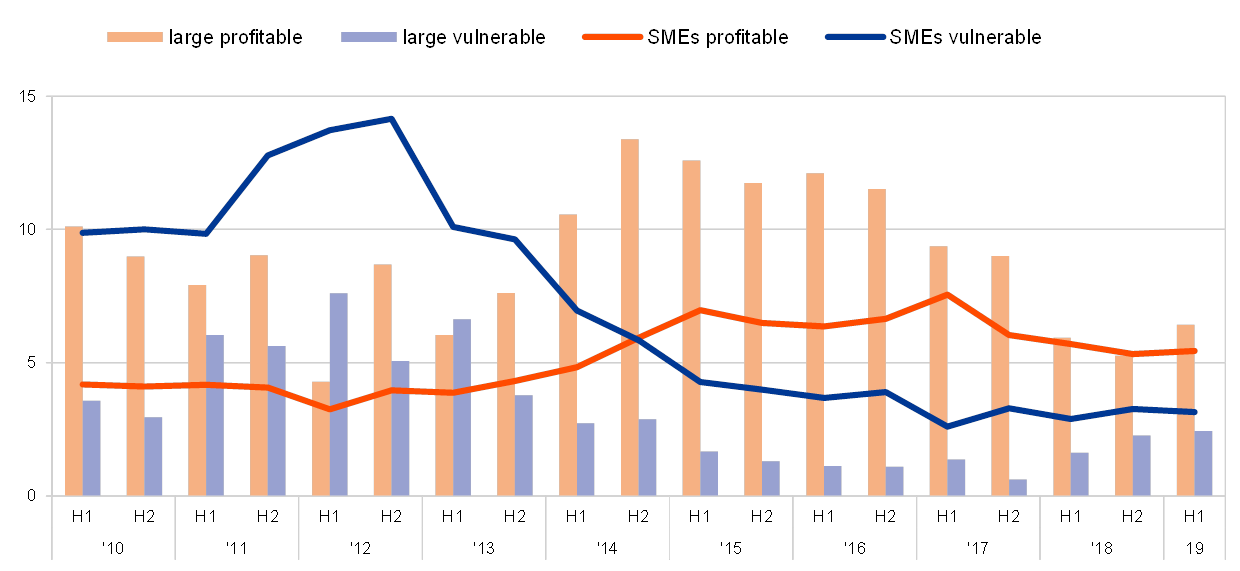
Base: All enterprises. Figures refer to rounds 3 (March-September 2010) to 21 (April-September 2019) of the survey.Note: for definitions, see footnote 8 of the report.
Q2. Have the following company indicators decreased, remained unchanged or increased over the past six months?
Looking at size differences, smaller firms remain more vulnerable than large companies, but the gap has declined over time. In this survey round the percentage of vulnerable firms among large firms increased slightly to 2.4%, from 2.3%. The financial situation of large enterprises remained better than that of SMEs, and there was a higher net percentage of profitable large firms (6.4%, from 5.3% in the previous survey round).
Focusing on SMEs, the indicators of profitable and vulnerable firms reveal some heterogeneity across countries (see Chart 4 for the euro area and the large countries). The percentage of distressed companies remained high in Italy (12%, up from 7.3%) and Spain (10.1% from 3%), followed by France (6.5%, up from 4.5%), although much lower than the peaks reached during the sovereign debt crisis. The percentage of vulnerable firms also rose in Germany (1.6%, from 1.2%). The net percentage of profitable firms in turn declined in Spain and Italy, but rose in Germany, France and the euro area as whole. For the trend in other euro area countries, see Chart 3a in Annex 1.
Vulnerable and profitable SMEs
(percentages of respondents)
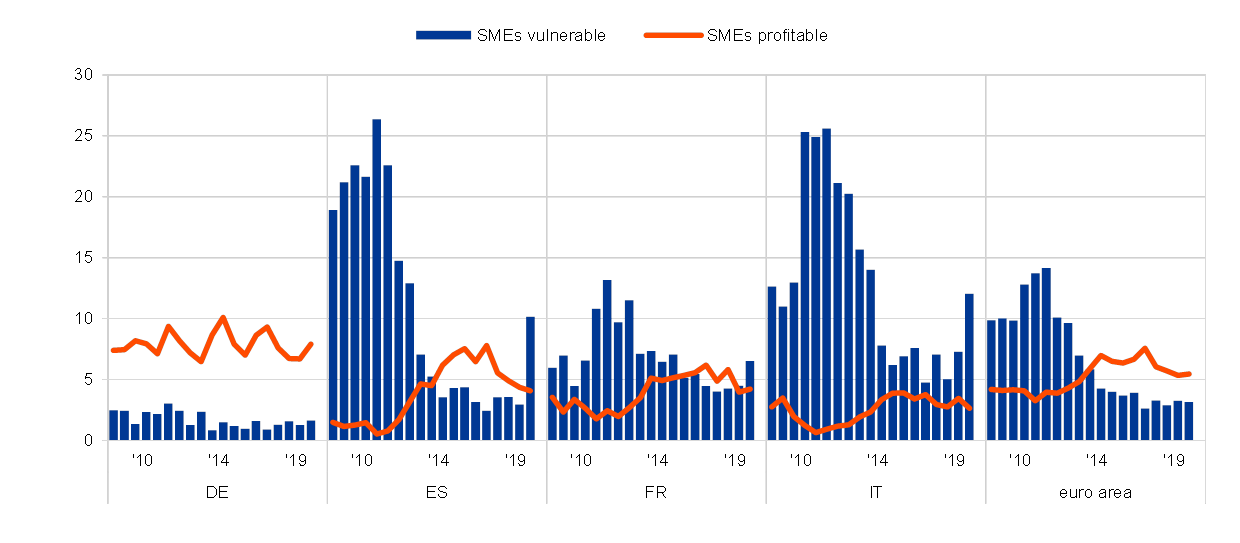
Base: All SMEs. Figures refer to rounds 3 (March-September 2010) 21 (April-September 2019) of the survey.
Q2. Have the following company indicators decreased, remained unchanged or increased over the past six months?
In this survey round two sets of ad hoc questions were included, aimed at: 1) featuring the main export markets of euro area enterprises; and 2) exploring the impact of late payments on enterprises’ business plans.
Box 1 Ad hoc questions: the main export markets and impact of late payments
Main features of euro area SME exports in 2018
Regarding external markets, the survey responses confirm that non-domestic sales are important for euro area SMEs: 38% of SMEs exported some goods or services in 2018. Moreover, the percentage of exporting companies increases with company size: while only 25% of the micro firms report exports outside their domestic market, the percentage is higher for small (40%), medium (58%) and large companies (61%).
Regarding the composition of these exports, while SMEs and large companies exported predominantly within the euro area (87% and 95% respectively), a significant percentage of companies also exported outside the euro area: 55% of SMEs exported to non-euro area EU countries, 42% to other European countries and 48% to countries outside Europe (see Chart A).
Chart A
Export markets of euro area enterprises
(percentages of: (i) all exporting SMEs, left panel (ii) SMEs exporting outside Europe, right panel)
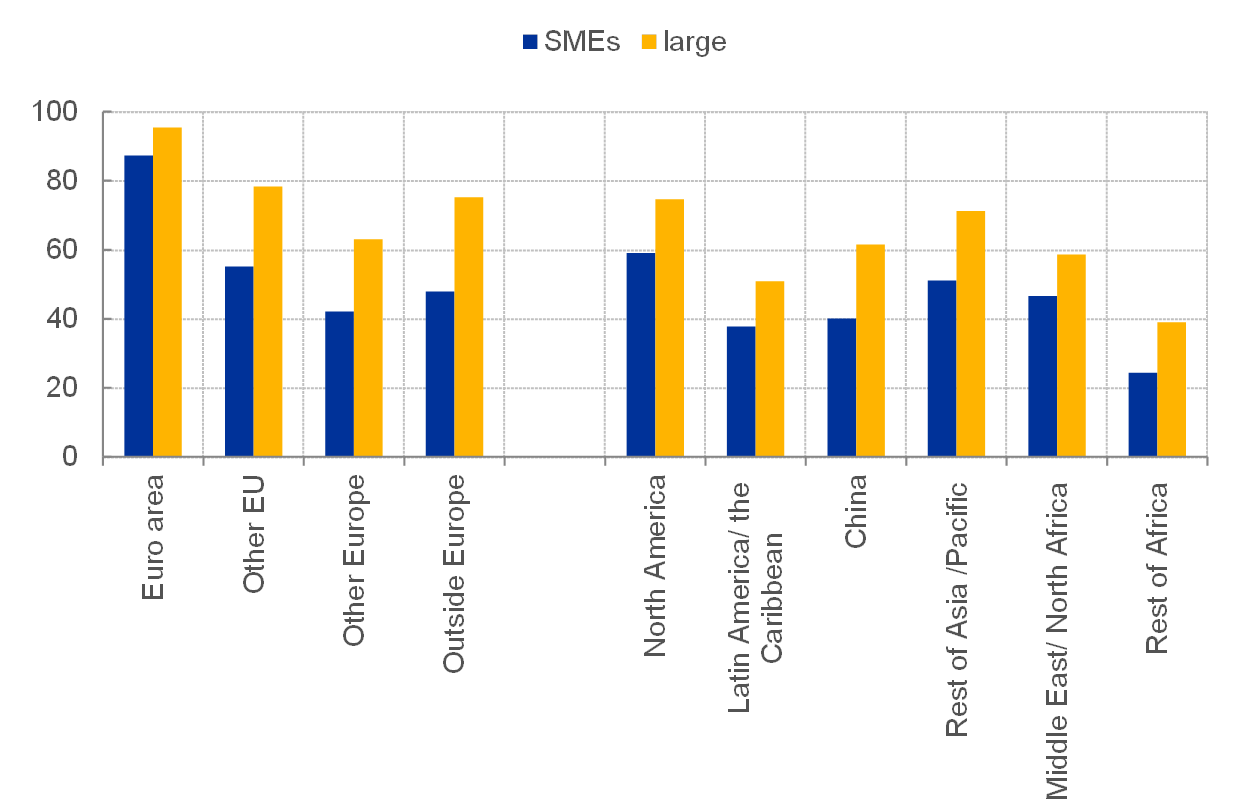
QA1: To which markets did your company export goods or services in 2018?
Base: Left panel- all enterprises that exported, right panel - all enterprises that exported outside Europe. Figures refer to round 21 (April to September 2019) of the survey.
Among SMEs exporting outside Europe, North America is the most common market destination (for almost 60% of SMEs), followed by Asia and the Pacific (about 50% excluding China, and 40% for China) and the Middle East and North Africa (47%).
As expected, larger companies report a greater dominance of non-domestic markets, but they show similar patterns of diversification as SMEs. More than 90% of large firms report exports to other euro area countries, almost 80% to other EU countries and 75% sell their goods and services outside Europe, particularly in North America (for 75%) and Asia and the Pacific (excluding China above 70%, and about 60% to China) which were the biggest markets for large euro area firms exporting outside Europe (see Chart A, right panel).
Late payments to euro area SMEs: frequency and impact
Another topic covered in this survey round was whether late payments[9] are perceived as a problem and what impact they have. Thirteen per cent of SMEs and large companies signalled that they experienced problems on a regular basis as a result of late payments from private and/or public entities. In addition, 31% of SMEs mentioned that these problems occurred occasionally in the last six months (30% of large enterprises). Across large euro area countries, the highest share of SMEs experiencing regular or occasional difficulties were reported in Italy (57%) and France (51%), followed by 40% in Spain and by about one-third of SMEs in Germany (see Chart B).
Chart B
Frequency of problems among euro area SMEs as a result of late payments
(percentage of respondents)
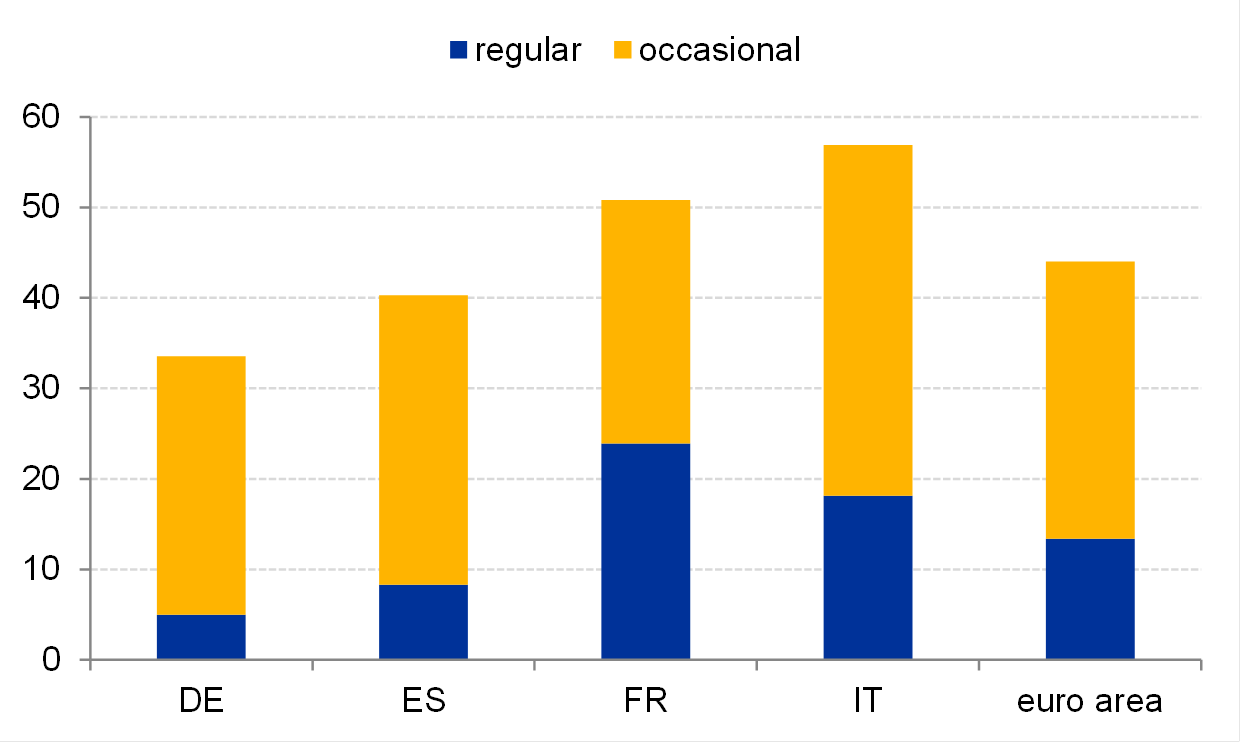
QA2: Has your company experienced problems due to late payments from any private or public entity in the past six months?
Base: All enterprises. Figures refer to round 21 (April to September 2019) of the survey.
Regarding the impact of late payments, payments to suppliers were the most frequently affected (reported by 34% of SMEs and 24% of large enterprises), but around 20% of SMEs also mentioned other consequences for investment or recruitment, production or operations, and repayment of loans or drawing additional financing (see Chart C). Investment and production plans for large companies, in contrast, appear to be more resilient to late payments (mentioned by only about 10% of large firms in both cases). Among the large euro area countries, payments to suppliers were particularly affected on a frequent basis as a result of late payments in Italy (40%) and France (34%). In addition, investment and production in Italy appear to be harmed more often (29% and 28% respectively) than in other large euro area economies (see Chart D).
Chart C
Impact of late payments on euro area enterprises
(percentage of respondents)
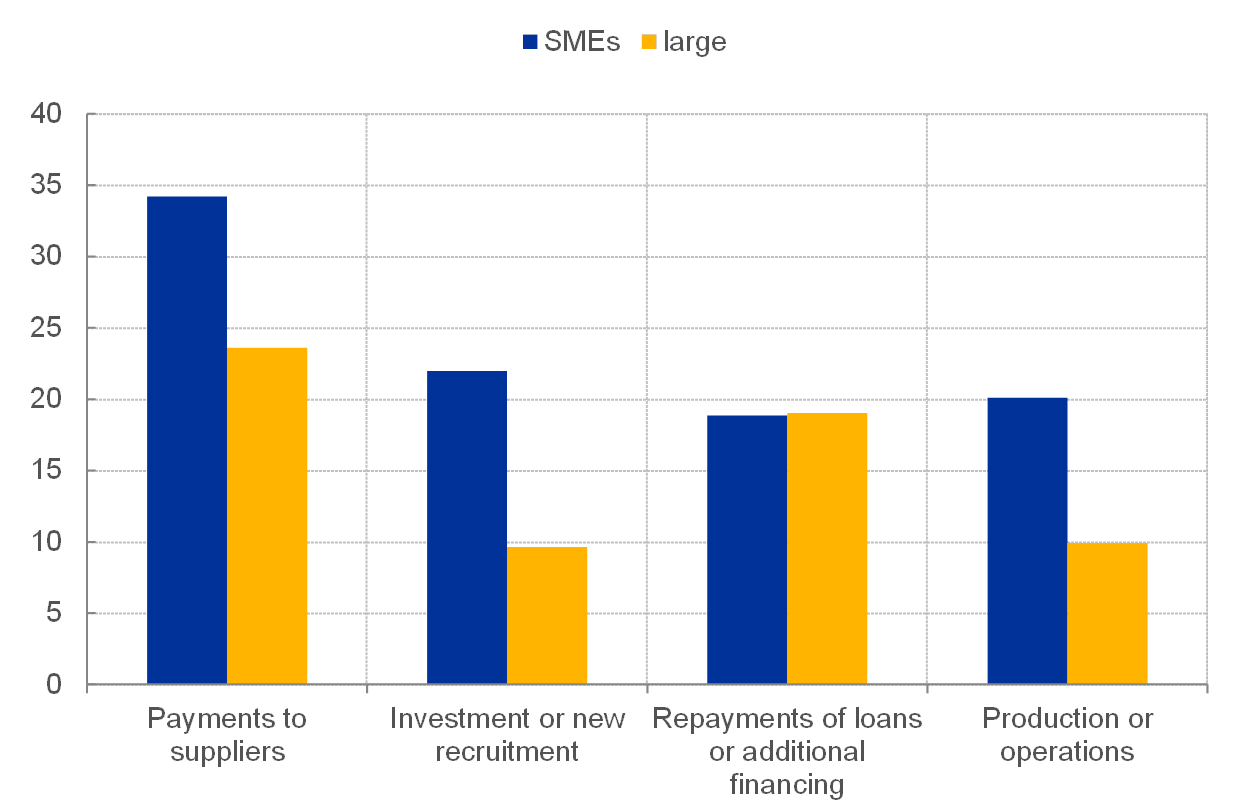
QA3: What were the consequences of those late payments?
Base: All enterprises that experienced regular or occasional problems due to late payments. Figures refer to round 21 (April to September 2019) of the survey.
Chart D
Impact of late payments on euro area SMEs
(percentage of respondents)
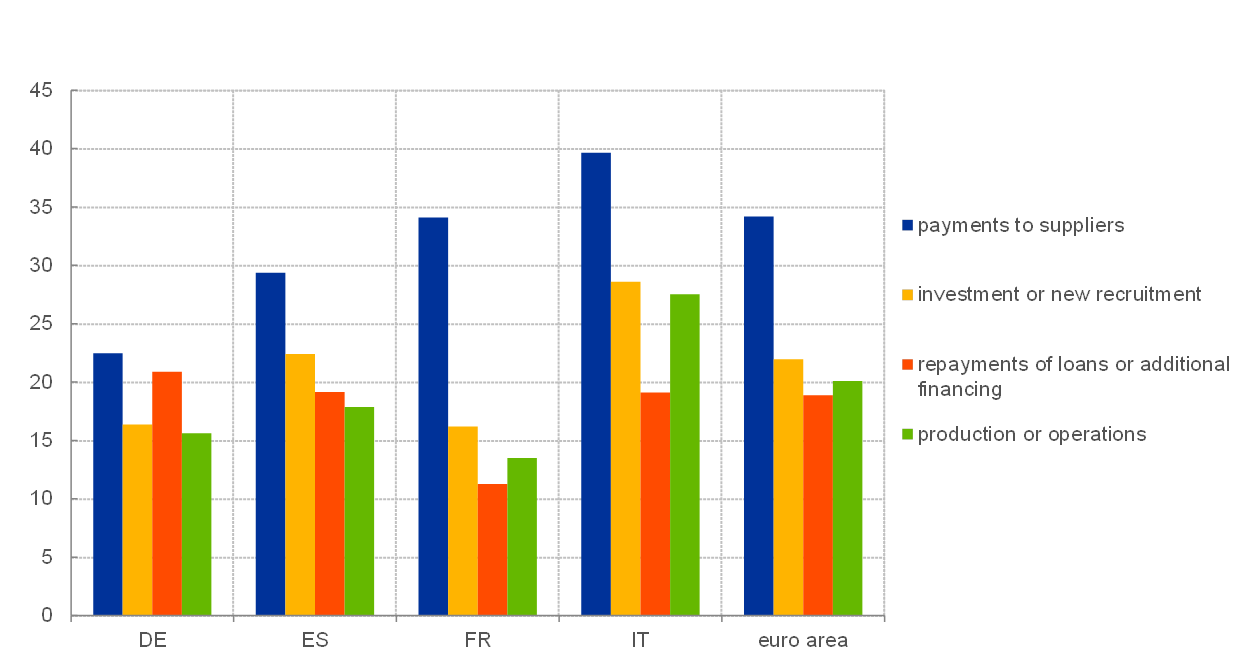
QA3: What were the consequences of those late payments?
Base: All enterprises that experienced regular or occasional problems due to late payments. Figures refer to round 21 (April to September 2019) of the survey.
2.2 Access to finance ranked as SME’s least important concern
Availability of skilled labour continues to be the dominant concern for euro area SMEs, together with the difficulty of finding customers, while access to finance remained their least important obstacle (see Chart 5). In this survey round, 28% of euro area SMEs cited “availability of skilled labour” as their main problem (up from 25% in the previous survey round), followed by “difficulty of finding customers” (22%, down from 23%).
The most important problems faced by euro area enterprises
(percentages of respondents)
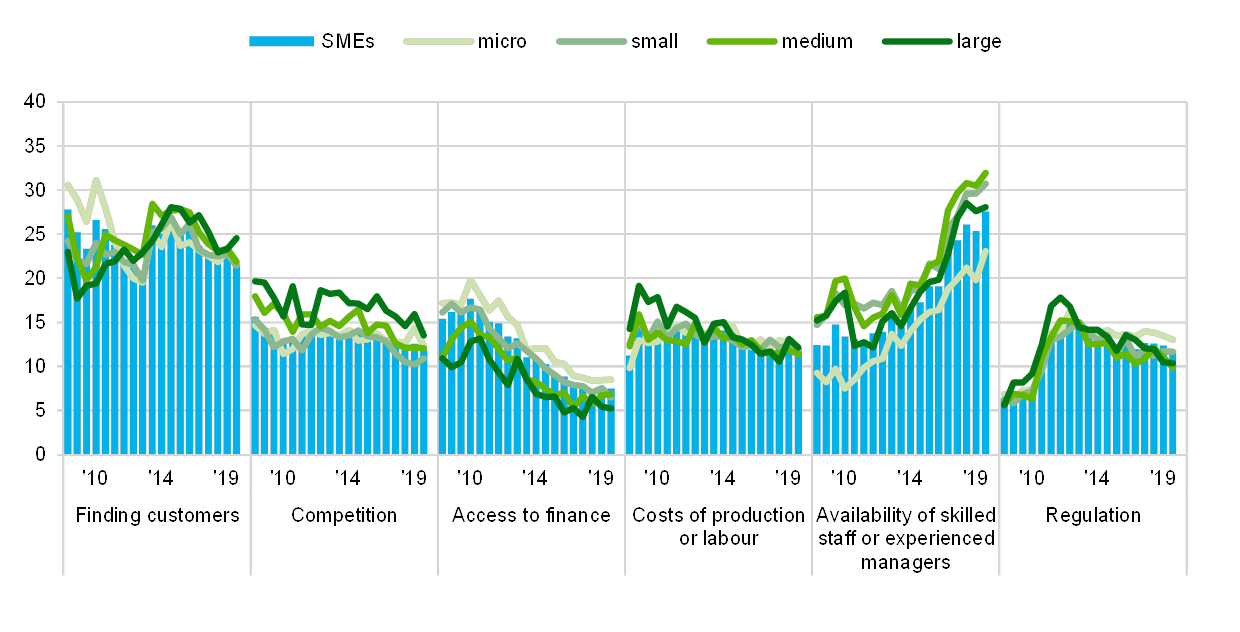
Base: All enterprises. Figures refer to rounds 3 (March-September 2010) to 21 (April-September 2019) of the survey.Notes: The formulation of the question has changed over the survey rounds. Initially, respondents were asked to select one of the categories as the most pressing problem. From round 8, all respondents were asked to indicate how pressing a specific problem was on a scale from 1 (not pressing) to 10 (extremely pressing). In round 7, the formulation of the question followed the initial phrasing for one-half of the sample and the new phrasing for the other half. In addition, if two or more items had the highest score in question Q0B on “how pressing the problems were, a follow-up question (Q0C) was asked to resolve this, i.e. which of the problems was more pressing, even if only by a small margin. This follow-up question was removed from the questionnaire in round 11. The past results from round 7 onwards were also recalculated, disregarding the replies to question Q0C. In round 12, the word “pressing” was replaced by the word “important”.
Q0. How important have the following problems been for your enterprise in the past six months?
Looking at small, medium and large euro area companies, the main concern across the board was “availability of skilled labour”, with percentages of 31%, 32% and 28% respectively, followed by “finding customers” (21%, 22% and 25% respectively). Micro firms, however, reported a somewhat similar concern regarding finding customers (22%) and finding skilled staff (23%). The differences across firm size may reflect that demand for staff is lower among micro firms, while the lack of skilled staff is a pressing problem for larger firms. “Access to finance”, in contrast, continues to be considered the least important obstacle for euro area SMEs (7%, marginally down from 8%), after “cost of production”, “regulation” and “competition” (all 12%), and broadly unchanged from the previous survey round.
Concerns about access to finance remained higher for SMEs as a whole than for large companies. While 9% and 6% of both micro and small and 7% of medium-sized enterprises signalled that access to finance was the main obstacle, only 5% of large companies did.
The euro area aggregate masks considerable differences across countries (see Charts 6 and 4a in Annex 1). Among the largest euro area countries, German (37%) and French SMEs (30%) most frequently cited the availability of skilled staff as their dominant concern, ahead of finding customers (26% and 15% respectively). Spanish (25%) and Italian (22%) SMEs instead reported finding customers as their main problem. Among other euro area countries, SMEs in Greece continued to be disproportionately affected by the lack of access to finance, with 21% (down from 25% nonetheless) of firms still citing it as their most important problem, well above the levels for the euro area as a whole (7%) and other individual countries, all of whom stated that this criterion remained in single digits.
The most important problems faced by euro area SMEs
(percentages of respondents)
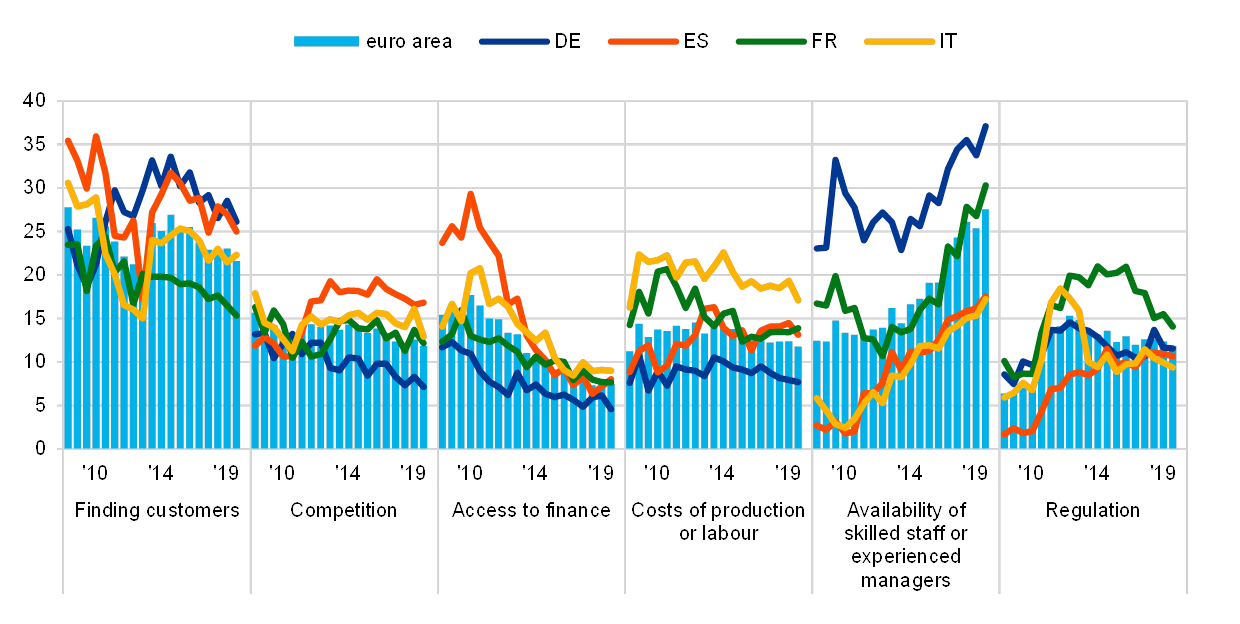
Base: All SMEs. Figures refer to rounds 3 (March-September 2010) to 21 (April-September 2019) of the survey.Note: See the notes to Chart 5.
Q0. How important have the following problems been for your enterprise in the past six months?
A similar picture emerges when looking at the responses, on a scale of 1-10, on whether “access to finance” is a problem in the current situation. SMEs in Greece continued to perceive it as a very important issue (rating it at 5.9 on average; see Chart 7), with only Portugal and Italy above the 5 mark (5.1 in both cases). The remainder of the countries reported scores close to or below the euro area average of 4.3, with SMEs in Finland continuing to report the lowest average score (2.9).
Importance of access to finance as perceived by SMEs across euro area countries
(left-hand scale: percentages; right-hand scale: weighted averages)
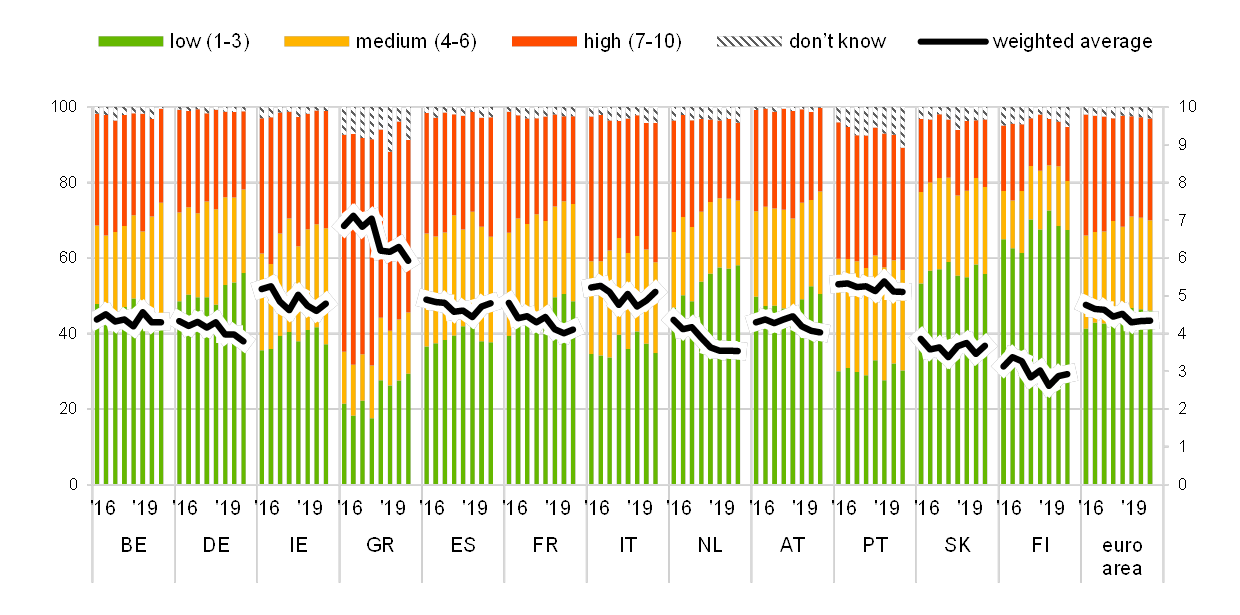
Base: All SMEs. Figures refer to rounds 14 (October 2015-March 2016) to 21 (April-September 2019) of the survey. Note: Enterprises were asked to indicate how important a specific problem was on a scale from 1 (not at all important) to 10 (extremely important). On the chart, the scale has been divided into three categories: low (1-3), medium (4-6) and high importance (7-10). The weighted average score is an average of the responses using the weighted number of respondents.
Q0b. How important have the following problems been for your enterprise in the past six months?
3 SMEs’ financing needs and sources
3.1 Banks remained the most relevant source of finance
Bank-related products remained the most relevant financing source for SMEs, ahead of market-based instruments and other sources of finance (see Chart 8). For the period from April to September 2019, about half of the euro area SMEs considered bank loans and credit lines to be relevant financial instruments for their businesses (50% in both cases).[10] Leasing or hire-purchase was relevant for 45% of SMEs, while 33% indicated that grants and subsidised loans (i.e. loans that involve support from public sources in the form of guarantees or other interventions) were a potential source of finance. Trade credit was mentioned as an important financial instrument by 28% of SMEs, while 24% mentioned internal funds as a source to finance their business. Lastly, 18% of SMEs pointed to other loans (for example from family, friends or related companies) as a relevant source of finance. Market-based instruments, such as equity (11%), debt securities (4%) and factoring (9%) were much less frequently considered as a potential source of finance. These responses imply very marginal changes to the sources of financing among SMEs compared with the previous survey round.
Relevance of financing sources for euro area SMEs
(over the preceding six months; percentages of respondents)

Base: All SMEs. Figures refer to round 21 (April-September 2019) of the survey.
Q4. Are the following sources of financing relevant to your enterprise, that is, have you used them in the past or considered using them in the future? If “yes”, have you obtained new financing of this type in the past six months?
The use of all financing instruments increased with firm size: the share of large firms that reported having used any given financing instrument was always higher than that of SMEs (see Chart 9). Short-term bank finance (credit line/bank overdraft/credit card) remained the most popular source of finance by some margin, followed by leasing and bank loans. Equity and debt securities, on the other hand, were among the least frequently used sources of finance. Those patterns were shared both among SMEs and larger firms.
Use of internal and external funds by euro area enterprises by firm size
(percentages of respondents that had used the respective instrument in the past six months)
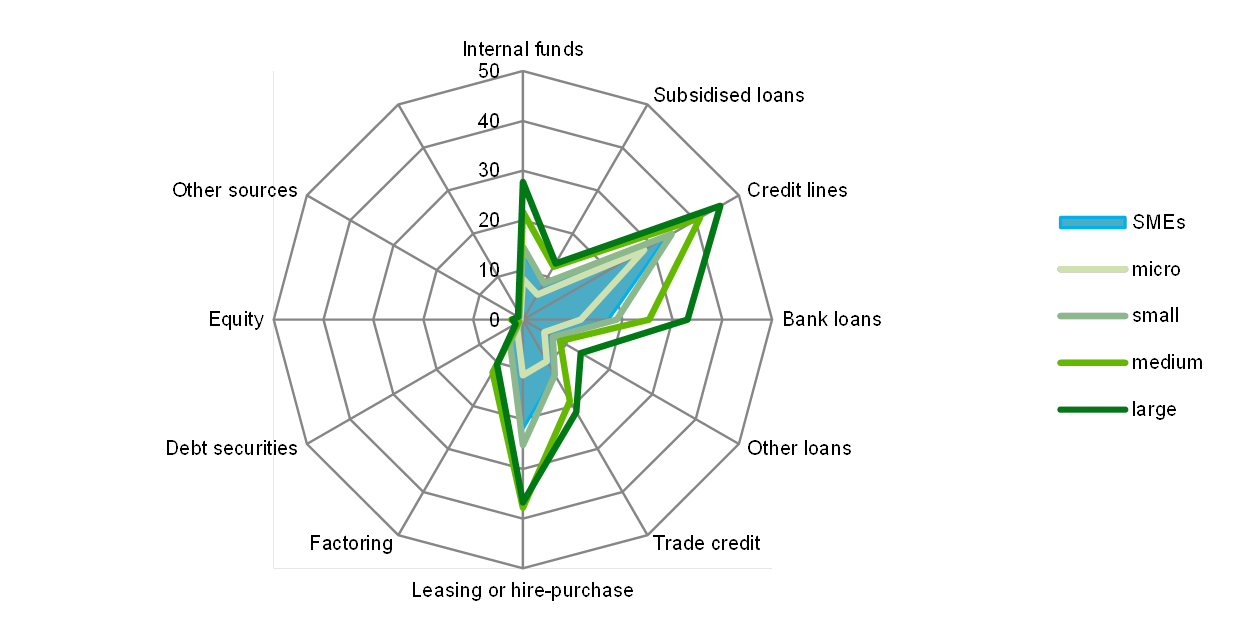
Base: All enterprises. Figures refer to round 21 (April-September 2019) of the survey.
Q4. Are the following sources of financing relevant to your enterprise, that is, have you used them in the past or considered using them in the future? If “yes”, have you obtained new financing of this type in the past six months?
Distinguishing between vulnerable and profitable SMEs[11] can make it possible to analyse the impact a company’s financial situation can have on the sources of finance used (see Chart 10). Vulnerable firms resorted to credit lines (53%) and bank loans (25%) as their main source of external financing to a much larger extent than profitable firms (26% and 12% respectively). In turn, profitable firms relied more on their internal funds, but also chose leasing or hire-purchases more frequently than vulnerable firms.
Use of internal and external funds by euro area SMEs across profitable and vulnerable firms
(percentages of respondents that had used the respective instrument in the past six months)
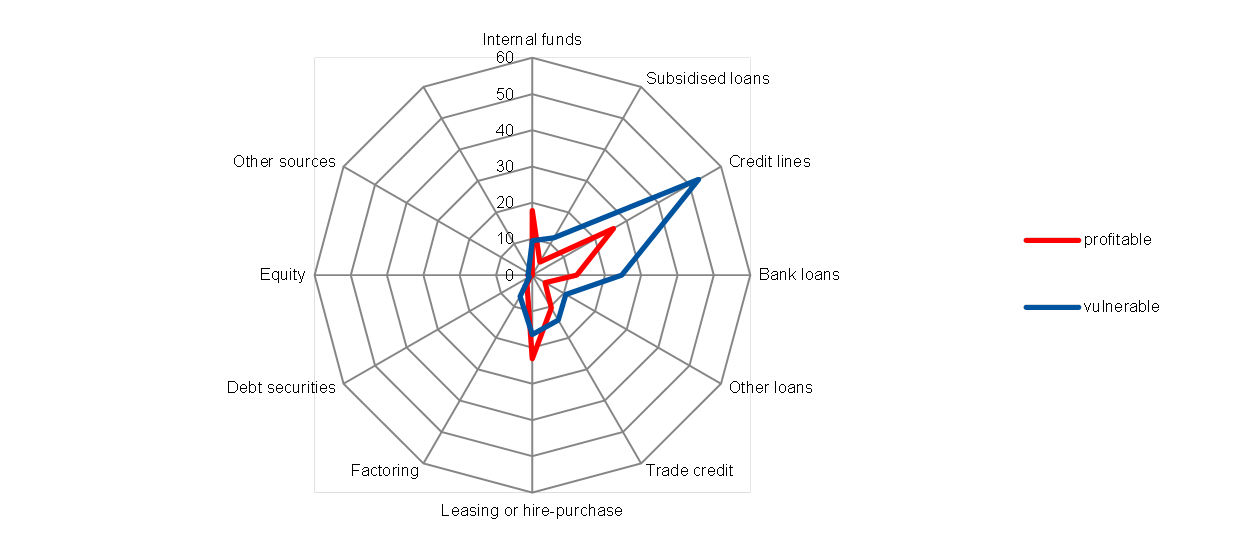
Base: All SMEs. Figures refer to round 21 (April-September 2019) of the survey.
Q4. Are the following sources of financing relevant to your enterprise, that is, have you used them in the past or considered using them in the future? If “yes”, have you obtained new financing of this type in the past six months?
3.2 Demand for external financing among euro area SMEs remained heterogeneous
Demand for most external financing instruments among SMEs continued to rise but appeared to soften (see Chart 11). SMEs reported a decrease in their demand for bank loans[12] (-1%, from 3%), while demand for credit lines and trade credit increased slightly less than before (4% and 7%, from 6% and 9% respectively). Demand for leasing and hire-purchase agreements remained unchanged (at 11%).
Change in external financing needs of euro area enterprises
(over the preceding six months; net percentages of respondents)

Base: Enterprises for which the respective instrument is relevant. Figures refer to rounds 14 (October 2015-March 2016) to 21 (April-September 2019) of the survey.Note: See the notes to Chart 1. The categories “Other loans” and “Leasing or hire-purchase” were introduced in round 12 (October 2014-March 2015). A financing instrument is “relevant” if the enterprise used the instrument in the past six months or did not use it but has experience of it (for rounds 1 to 10). From round 11 onwards, the respondents were asked whether the instrument was relevant, i.e. whether the enterprise had used it in the past or considered using it in the future. Given that the current concept of a “relevant” financing instrument differs from that used in the past, this might have an impact on the comparability over time for the subsequent questions. Caution should therefore be exercised when comparing the recent results with those of the previous rounds.
Q5. For each of the following types of external financing, please indicate if your needs increased, remained unchanged or decreased over the past six months.
Large firms reported a continued increase in external financing, albeit somewhat weaker than in the previous survey round. In net terms, a lower share of large firms reported increases in demand for bank loans (7%, from 11%) but higher for other loans (8% up from 2%). Demand for credit lines was unchanged (at 12%) while, on balanced terms, fewer large firms reported an increased need for trade credit (13%, from 18%) and leasing activity (12%, from 22%) than in the previous round.
Euro area SMEs reported a lower demand for bank finance than in the previous survey round, with significant heterogeneity across countries. Among the four largest euro area economies, SMEs indicated increasing needs for bank loans in Spain (2%, from 0%). SMEs in Italy (4%, from 8%) and France (4% from 12%) reported that their needs were still increasing, but less so than in the previous round, while the decline in the need for bank loans continued in Germany (-9%, from -6%, see Chart 12). The demand for credit lines also rose in Spain (5%, unchanged), France (11%, from 15%) and Italy (9%, from 10%), but continued to decline again in Germany (-5%, from -1%).
Change in external financing needs of euro area SMEs
(over the preceding six months; net percentages of respondents)

Base: SMEs for which the respective instrument is relevant. Figures refer to rounds 14 (October 2015-March 2016) to 21 (April-September 2019) of the survey.Note: see the notes to Charts 1 and 11.
Q5. For each of the following types of external financing, please indicate if your needs increased, remained unchanged or decreased over the past six months.
For other types of external financing for SMEs, there was more heterogeneity across the large euro area countries. Compared with the last survey round, SMEs reported a larger increase in the demand for other type of loans (from family, friends and related enterprises or shareholders) in France and Spain, but a somewhat lower increase in Italy and a decline in Germany. Demand for leasing and hire-purchase in turn increased most in France, while it rose at a similar speed in Germany and increased by less in Spain and Italy. Resort to trade credit, however, was reported lower than in the previous survey round in the four countries.
In the other euro area countries, demand for external financing continued to be strongest in Greece. Greek SMEs reported strong demand for bank loans (18% from 26%) and credit lines (22% from 32%) respectively (see Chart 5a in Annex 1).
3.3 SMEs continued to use financing mostly for fixed investments, inventory and working capital
Financing from external and internal sources continued to be used mainly for fixed investment, followed by inventories and working capital. Financing for hiring and training new employees and for developing and launching new products remained broadly unchanged from the previous survey round (see Chart 13). About 42% of SMEs (43% previously) reported using financing for fixed investment, while 34% (unchanged) mentioned inventory and working capital.
Purpose of the financing as perceived by euro area enterprises
(over the preceding six months; percentages of respondents)

Base: All enterprises. Figures refer to rounds 14 (October 2015-March 2016) to 21 (April-September 2019) of the survey.Note: the figures are based on the new question introduced in round 11 (April-September 2014).
Q6A. For what purpose was financing used by your enterprise during the past six months?
The prevalence of fixed investment continued to be associated with company size. While 63% of large firms reported using funds for fixed investment, this applied to only 31% of micro firms. Investment in working capital and inventories was also related to firm size (46% for large firms, but only 31% for micro firms). Less frequently, SMEs used financing to hire and train employees (22%, unchanged), develop new products (20%, from 21%) and refinance obligations (13%, unchanged).
Among the firms in large euro area countries, German SMEs continued to stand out in terms of use of funds for fixed investment, hiring and training, and refinancing purposes. About 50% of German SMEs reported using funding for fixed investment, compared with only 36% of Spanish or 38% of French SMEs. Spanish firms continued to make strong use of financing for inventory and working capital (46%) more frequently than for fixed investment (see Chart 14).
Purpose of the financing as perceived by SMEs across euro area countries
(over the preceding six months; percentages of respondents)

Base: All SMEs. Figures refer to rounds 14 (October 2015-March 2016) to 21 (April-September 2019) of the survey.Note: see the note to Chart 13.
Q6A. For what purpose was financing used by your enterprise during the past six months?
4 Availability of external financing for SMEs in the euro area
4.1 Continued improvement in the availability of external financing amid growing concerns in relation to macroeconomic factors
Availability of all external financing sources mostly unchanged from the previous survey round
In the latest survey round, SMEs continued to report improved availability of external financing sources relevant for their business (see Chart 15).[13] For bank loans in particular, one of the most important sources of funding for SMEs, the net percentage of respondents indicating improved availability increased to 10% (from 9%). For all other financing instruments, the net percentage of SMEs reporting easier access remained positive and mostly unchanged at 8% for credit lines, at 9% for trade credit and at 15% for leasing and hire-purchase, while it marginally decreased to 8% (from 9%) for other loans.
Change in the availability of external financing for euro area enterprises
(over the preceding six months; net percentages of respondents)
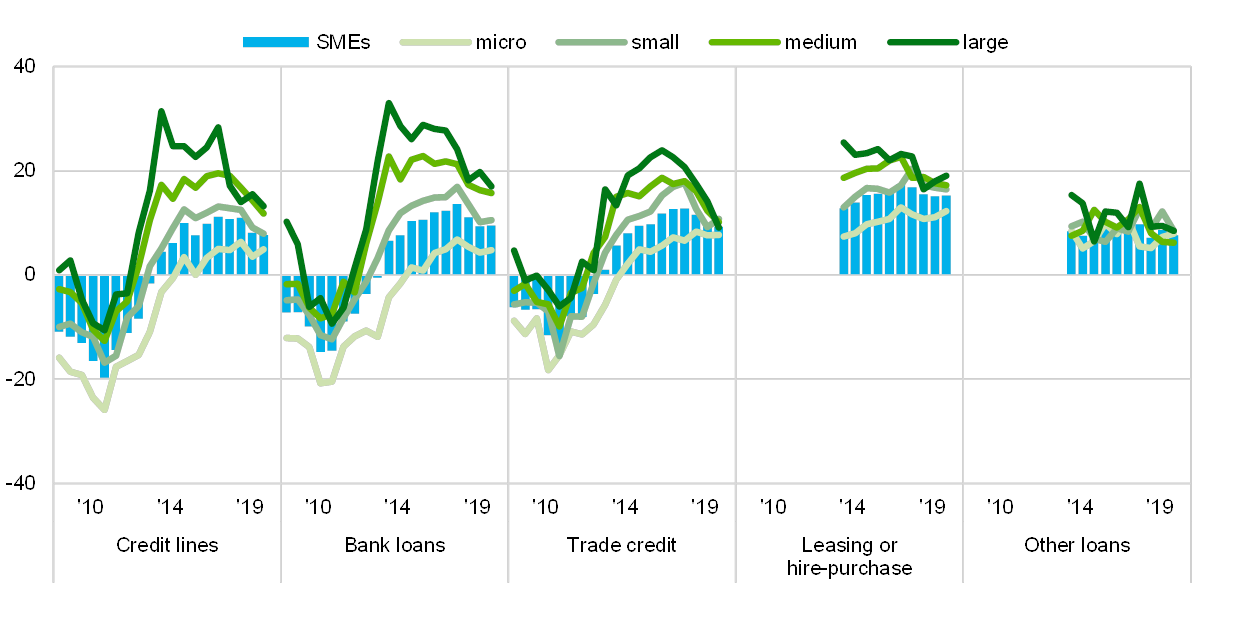
Base: Enterprises for which the respective instrument is relevant. Figures refer to rounds 3 (March-September 2010) to 21 (April-September 2019) of the survey. Note: see the notes to Charts 1 and 11.
Q9. For each of the following types of financing, would you say that their availability has improved, remained unchanged or deteriorated for your enterprise over the past six months?
Large and medium-sized companies continued to be the most positive in their assessment of the availability of external financing but with some signs of moderation. In this survey round, the net percentage of firms reporting better access to external funding declined for large enterprises, narrowing the gap with respect to smaller firms, particularly in the case of bank loans, for which only a net 5% of micro firms reported better availability, whereas a net 17% of large companies did. The differences are somewhat smaller for trade credit (8%, compared with 9%), credit lines (5%, compared with 13%), other loans (8% for both size classes) and leasing and hire-purchase (12%, compared with 19%).
Across countries, the differences are narrowing (see Chart 16 and Chart 5a in Annex 1). Higher net percentages of respondents indicated better availability of bank loans, particularly in Greece, Belgium and France, which were counterbalanced by lower percentages in the case of Irish and Spanish SMEs. Overall, SMEs in Ireland, Portugal, Spain and Greece were most upbeat about their external financing environment.
Change in the availability of external financing for euro area SMEs
(over the preceding six months; net percentages of respondents)
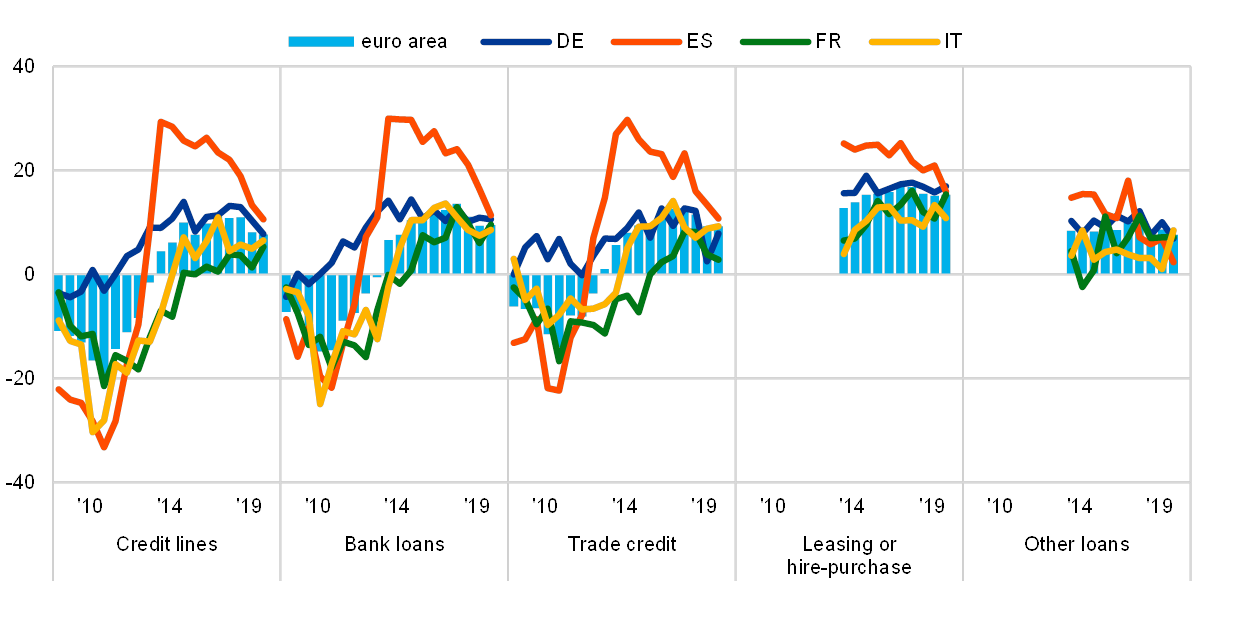
Base: SMEs for which the respective instrument is relevant. Figures refer to rounds 3 (March-September 2010) to 21 (April-September 2019) of the survey.Note: see the notes to Charts 1 and 11.
Q9. For each of the following types of financing, would you say that their availability has improved, remained unchanged or deteriorated for your enterprise over the past six months?
External funding availability seen to rise faster than needs
For the euro area as a whole, SMEs perceived the improvements in their access to external funds to be greater than the corresponding financing needs, resulting in a negative external financing gap of -4% (from -3%, see Chart 17). At the level of individual euro area countries, the financing gap was negative in the majority of cases, most notably in Germany (-9%), Austria and Portugal (both -8%) (see also Chart 6a in Annex 1). In Ireland, external funding availability and needs were in balance in the latest survey round, while SMEs in Greece continued to report positive financing gaps (3%, from 11%).
Change in the external financing gap perceived by SMEs across euro area countries
(over the preceding six months; weighted net balances)
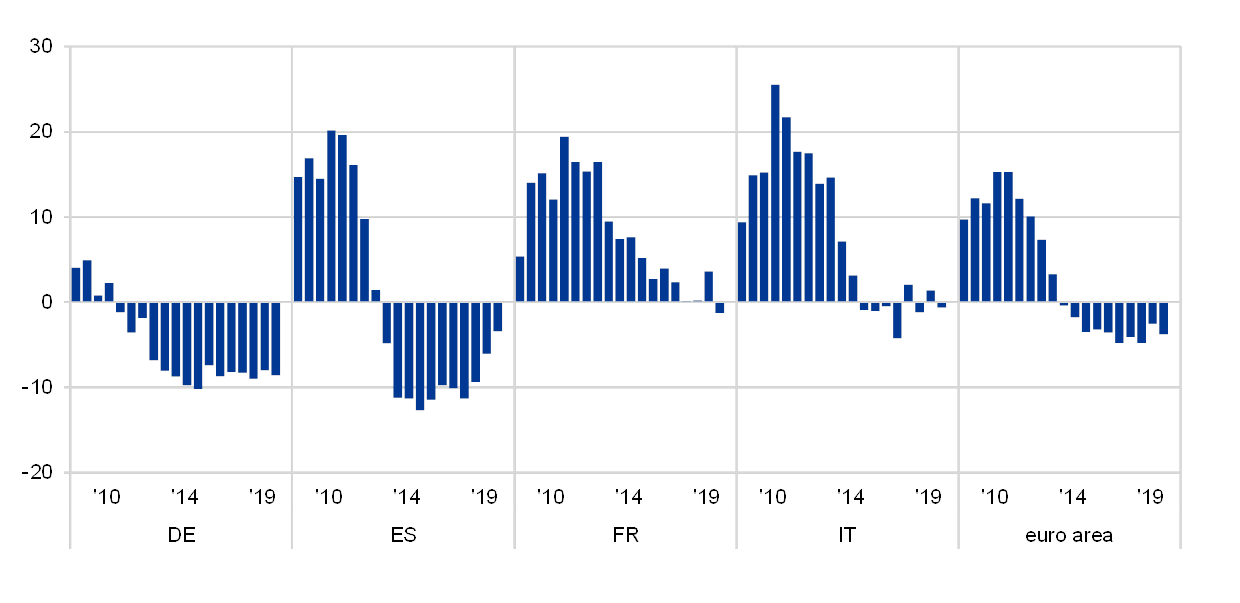
Base: SMEs for which the respective instrument is relevant. “Not applicable” and “Don’t know” answers are excluded. Figures refer to rounds 3 (March-September 2010) to 21 (April-September 2019) of the survey.Notes: See the notes to Chart 11. The financing gap indicator combines both financing needs and availability of bank loans, credit lines, trade credit, equity and debt securities at the firm level. For each of the five financing instruments, the indicator of the perceived change in the financing gap takes the value of 1 (-1) if the need increases (decreases) and availability decreases (increases). If enterprises perceive only a one-sided increase (decrease) in the financing gap, the variable is assigned a value of 0.5 (-0.5). The composite indicator is the weighted average of the financing gap related to the five instruments. A positive value of the indicator suggests an increasing financing gap. Values are multiplied by 100 to obtain weighted net balances in percentages.
Q5. For each of the following types of external financing, please indicate if your needs increased, remained unchanged or decreased over the past six months.Q9. For each of the following types of financing, would you say that their availability has improved, remained unchanged or deteriorated for your enterprise over the past six months?
SMEs signalled growing concerns in relation to macroeconomic factors affecting their access to external finance
Rising macroeconomic uncertainty was reflected in the replies of SMEs regarding the impact of various factors on the availability of external finance (see Chart 18). Specifically, SMEs perceived changes in the general economic outlook to have negatively affected their access to finance (-13% from -9%). In addition, access to public financial support continued to register as a negative factor in net terms, as in the previous survey rounds. By contrast, the firm-specific outlook (5%, from 10%), firms’ own capital (18%, from 17%) and firms’ credit history (17%, from 16%) continued to improve SMEs’ perceptions of the availability of external financing.
Change in factors with an impact on the availability of external financing to euro area enterprises
(over the preceding six months; net percentages of respondents)
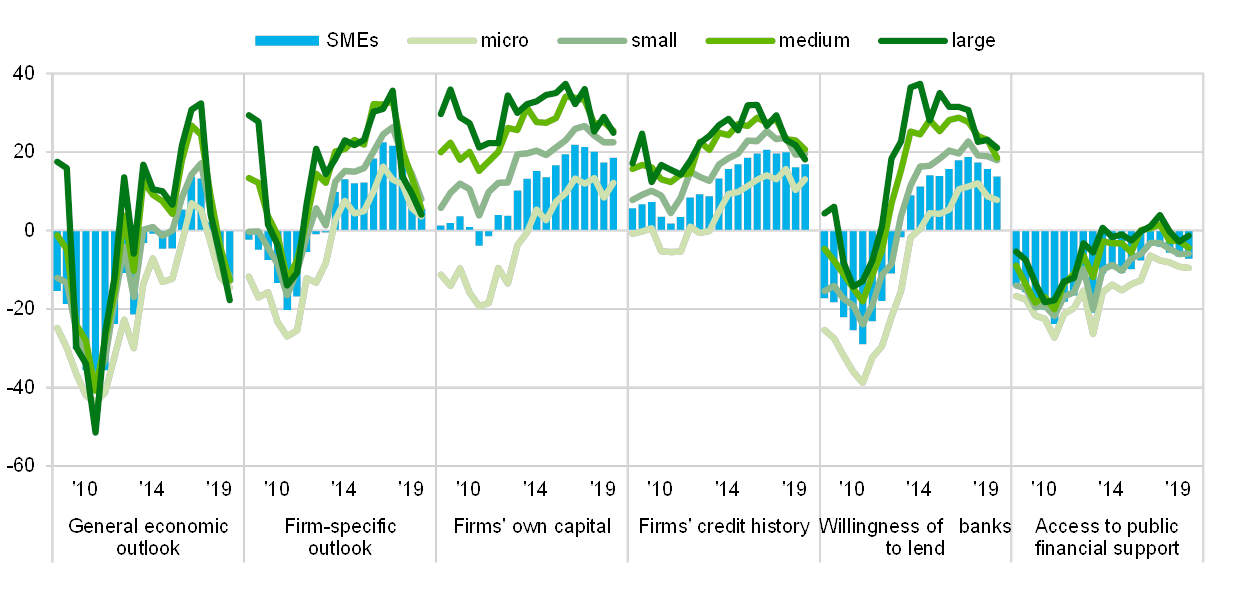
Base: All enterprises; for the category “Willingness of banks to lend”, enterprises for which at least one bank financing instrument (credit line, bank overdraft, credit card overdraft, bank loan, subsidised bank loan) is relevant. Figures refer to rounds 3 (March-September 2010) to 21 (April-September 2019) of the survey.Note: from round 11 (April-September 2014), the category “Willingness of banks to provide a loan” was reformulated slightly to “Willingness of banks to provide credit to your enterprise”.
Q11. For each of the following factors, would you say that they have improved, remained unchanged or deteriorated over the past six months?
In this survey round, large and medium-sized enterprises conveyed a more negative view of the business environment influencing their access to external finance than SMEs. 18% of large enterprises and 13% of medium-sized ones reported that the general economic outlook might have become an impediment for their access to external finance (from -6% and -4%, respectively). Regarding firm-specific variables, the assessment by medium and large enterprises continued to improve in net terms, albeit by much less compared with the previous survey rounds. For the willingness of banks to lend, the net percentage of micro firms indicating better conditions declined (to 8%, from 9%), as was the case for the other size classes, with the highest percentages for large and medium-sized enterprises (at 21% and 19%).
In the largest euro area countries, SMEs’ negative sentiment about the business environment increased considerably, while nearly all other factors affecting their access to external finance receded further relative to the previous survey round (see Chart 19). SMEs in Spain (-26%, from 8%), Italy (-16%, from -17%), France (-7%, from -11%) and Germany (-15%, from -6%) acknowledged the negative contribution made by the general economic outlook to the availability of external financing.
Change in factors with an impact on the availability of external financing to euro area SMEs
(over the preceding six months; net percentages of respondents)
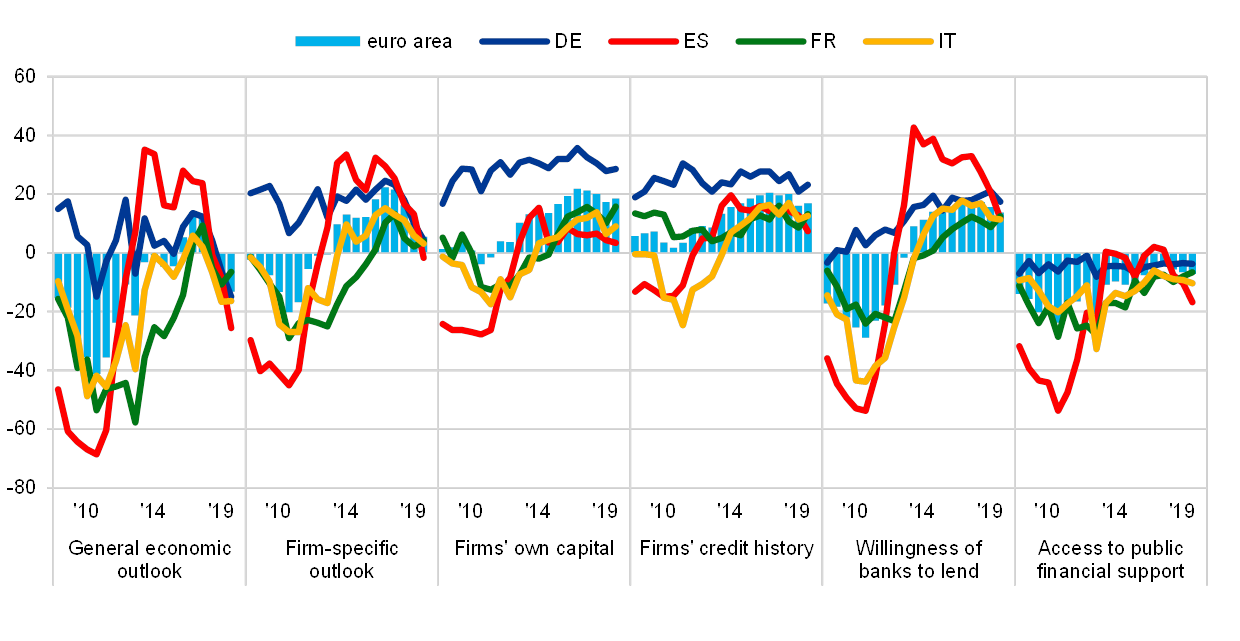
Base: All SMEs; for the category “Willingness of banks to lend”, SMEs for which at least one bank financing instrument (credit line, bank overdraft, credit card overdraft, bank loan or subsidised bank loan) is relevant. Figures refer to rounds 3 (March-September 2010) to 21 (April-September 2019) of the survey.Note: from round 11 (April-September 2014), the category “Willingness of banks to provide a loan” was reformulated slightly to “Willingness of banks to provide credit to your enterprise”.
Q11. For each of the following factors, would you say that they have improved, remained unchanged or deteriorated over the past six months?
On balance, SME’s in the other euro area countries also considered the general economic outlook as an impediment to their access to finance. The highest percentages were recorded in Finland (-24%, from -7%) and Slovakia (-16%, from -5%). By contrast, SMEs in Greece were the only ones reporting a somewhat more positive general economic outlook (16% from -23%).
At the same time, banks’ willingness to provide credit continued to improve. In this survey round, 14% of SMEs reported, in net terms, an increasing willingness of banks to lend (down from 16%), although the net percentage has remained on the high side since 2014.
Across countries, the net percentage of SMEs that felt there had been an improvement in the supply of bank credit declined in Germany (17%, from 21%), Spain (12%, from 21%) and Italy (11%, from 12%). By contrast, the percentage increased in France to 12% from 9%. In the other countries (see Chart 7a in Annex 1), the willingness of banks to lend was seen as having declined most in the Netherlands (5%, down from 11%) and Finland (11%, down from 16%), with the strongest increase in Greece (19%, up from 5%).
4.2 No significant changes in financing obstacles for SMEs
The share of SMEs reporting obstacles to obtaining a bank loan remained unchanged and still above the corresponding figure for large enterprises (see Chart 20, panel a). Among enterprises judging bank loans relevant for their funding, 7.4% (unchanged) of SMEs faced obstacles to obtaining a loan; the share declined to 4.9% for large enterprises (from 5.8%). Looking at the different components of the financing obstacles indicator, the proportion of SMEs discouraged from applying for a loan increased slightly to 4.2% from 4.1%, as was the case for large enterprises (to 3.2%, from 2.8%). At the same time, the proportion of loan applications rejected increased slightly for SMEs (1.7%, from 1.6%), but declined for large enterprises (0.6%, from 0.9%). By contrast, a slightly lower percentage of large companies reported receiving only a limited part of the loan amount requested (1.1%, compared with 1.2% for SMEs). Almost no enterprise (either SME or large) considered the cost of a loan to be too high.
Obstacles to receiving a bank loan
Panel a: Euro area SMEs and large enterprises
(over the preceding six months; percentages of respondents)

Base: Enterprises for which bank loans (including subsided bank loans) are relevant. Figures refer to rounds three (March-September 2010) to twenty-one (April-September 2019) of the survey.Notes: Financing obstacles are defined here as the total of the percentages of enterprises reporting loan applications which were rejected, loan applications for which only a limited amount was granted, loan applications which resulted in an offer that was declined by the enterprises because the borrowing costs were too high, and enterprises that did not apply for a loan for fear of rejection (discouraged borrowers). The calculation of the indicator starts in 2010, when the question on applications for credit lines was first included in the questionnaire. The components of the financing obstacles indicator were affected by the amendments to the questionnaire in round eleven (filtering based on the relevance of the financing instrument and addition of the new category “My application is still pending”), and past data have been revised accordingly. The figures include the categories “My application is still pending” and “Don’t know”.
Panel b: SMEs across euro area countries
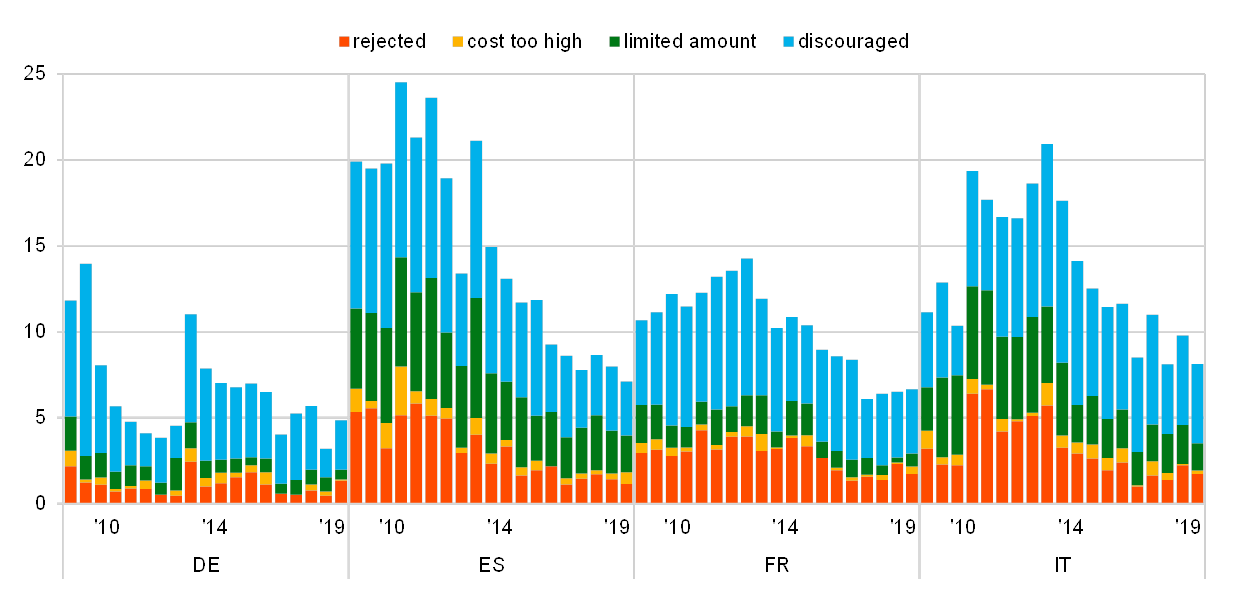
Across the largest euro area countries, the share of SMEs perceiving financing obstacles rose in Germany and France but declined in the other countries (see Chart 20, panel b). In Germany, an increase to 4.9% (from 3.2%) in the percentage of SMEs facing financing obstacles was a consequence of SMEs being more discouraged from applying for a loan (2.9%, from 1.6%) and receiving more rejections of their loan applications (1.3%, from 0.5%). Despite this increase, the percentage of financially-constrained enterprises in Germany remains the lowest among the major euro area countries. French SMEs also reported a small increase in financing obstacles (6.7% from 6.5%), mainly as a result of more price- and quantity-constrained firms. By contrast, SMEs in Italy and Spain reported reductions in the share of financing constraints (from 9.8% to 8.1% in Italy and from 8% to 7.1% in Spain) as fewer SMEs signalled they were discouraged, rejected or quantity-constrained.
In the remaining euro area countries, large increases in financing obstacles were reported by Slovakian SMEs (8.7%, from 5.9%). Greek SMEs remained the most financially constrained but the share declined to 23.5% (from 29.9%). Overall, cross-country differences in the euro area continued to decrease.
In line with past rounds of the survey, a small share of SMEs applied for a bank loan, even when focusing only on firms that deemed such financing relevant for their business (see Chart 8a in Annex 1). At the level of the euro area, 26% of SMEs applied for a loan, while 43% of SMEs did not apply because of sufficient availability of internal funds. Among firms submitting a loan application, 72% reported being successful in obtaining the full amount requested (see Chart 9a in Annex 1). Among large enterprises, 87% received the full amount requested.
4.3 Declining interest rates while other costs of financing continued to increase
In this survey round a net percentage of SMEs reported declines in interest rates on bank loans, reaching -9% (down from 4% in the previous round), though micro firms still reported increases (1%, from 11%) (see Chart 21). SMEs continued to report an increase in other costs of financing, such as charges, fees and commissions, albeit slightly less than in the previous survey round (29%, from 30%). Other terms and conditions of bank loans were considered to have improved by a similar net percentage of SMEs compared to the previous round, including the available size of a loan or credit line (12%, from 11%), the available maturity (2%, from 3%), collateral requirements (12%, from 13%) and other requirements (15%, from 14%).
Change in terms and conditions of bank financing for euro area enterprises
(over the preceding six months; net percentages of respondents)
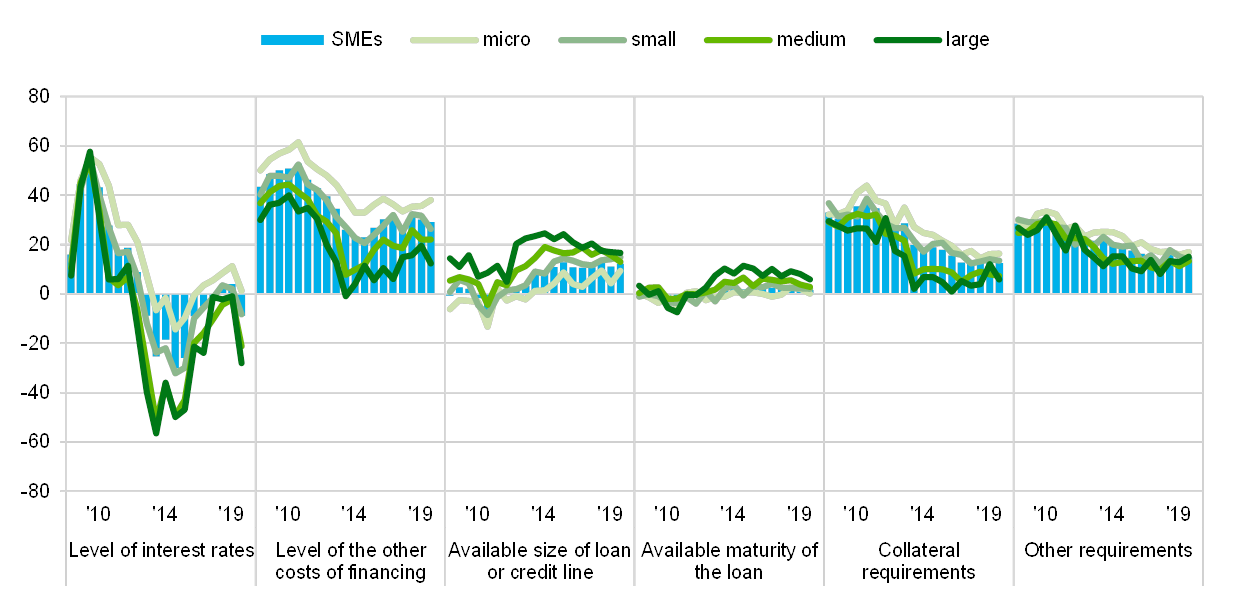
Base: Enterprises that had applied for bank loans (including subsidised bank loans), credit lines, or bank or credit card overdrafts. Figures refer to rounds 3 (March-September 2010) to 21 (April-September 2019) of the survey.Note: see the notes to Chart 1.
Q10. Please indicate whether the following items increased, remained unchanged or decreased in the past six months.
Large enterprises indicated a strong fall in interest rates but smaller increases in other costs of financing. A substantial net percentage of large enterprises reported lower interest rates on loans granted to them (-28%, from -1%). The corresponding figure for medium-sized firms was also much lower (-21%, from -2%). At the same time, a smaller net share of large enterprises indicated rises in other costs of financing (12%, from 20%) and in collateral requirements (6%, from 12%), while other terms and conditions remained more stable with respect to the previous survey round: other requirements (15%, up from 13%), size of available loans or credit lines (17%, unchanged) and available maturity (6%, down from 8%).
Developments in interest rates were mixed in the large euro area economies (see Chart 22). The net percentage of SMEs reporting increasing interest rates declined notably in Italy (5%, from 27%), while a higher net percentage of SMEs in France (-34%, from -8%) reported reductions in interest rates, as in Germany ( -9%, from -7%). In Spain, SMEs reported a slight increase in interest rates (2% from -1%) for the first time since 2014. Likewise, a smaller share of SMEs reported increases in other costs of financing in France (28% from 37%) and Italy (30% from 39%). By contrast, more SMEs in Germany (32%, from 22%) and Spain (28% from 20%) signalled an increase in other costs of financing.
Change in terms and conditions of bank financing for euro area SMEs
(over the preceding six months; net percentages of respondents)

Base: SMEs that had applied for bank loans (including subsidised bank loans), credit lines, or bank or credit card overdrafts. Figures refer to rounds 3 (March-September 2010) to 21 (April-September 2019) of the survey.Note: see the notes to Chart 1.
Q10. Please indicate whether the following items increased, remained unchanged or decreased in the past six months.
In the other euro area countries, SMEs reported lower interest rates, with the exception of Irish SMEs (see Charts 10a and 11a in Annex 1). With regard to increases in other costs of financing (charges, fees and commissions), SMEs in most countries reported some deceleration relative to the previous survey round, except in Belgium, where the net percentage reporting increases reached 27% (from 24%), as well as in Ireland (35% from 31%), Greece (34%, from 22%), Portugal (31%, from 27%) and Slovakia (44%, from 41%).
When asked about interest rates charged by banks on credit lines and overdrafts between April and September 2019, SMEs signalled some increases (see Chart 23)[14]. The median interest rate for SMEs increased by 14 basis points to 2.1%. By contrast, interest rates for large enterprises declined to 1.0% (from 1.2%), considerably below the borrowing costs for all types of SMEs, particularly when compared with micro firms (3.4%, up from 3.0%).
Interest rate charged for a credit line or bank overdraft to euro area enterprises
(percentages)

Base: Enterprises that had successfully applied for a credit line or bank overdraft or that did not apply because the cost was too high. Figures refer to rounds 14 (October 2015-March 2016) to 21 (April-September 2019) of the survey. Note: the interquartile range is defined as the difference between the 75th percentile and the 25th percentile. The figures are based on the question introduced in round 11 (April-September 2014).
Q8B. What interest rate was charged for the credit line or bank overdraft for which you applied?
In most large euro area countries, the interest rate of bank overdrafts and credit lines either increased or remained unchanged. The highest increases were signalled in Germany where the reported median rate rose by 35 basis points to 3% and in Spain (to 2.2%, up by 23 basis points). By contrast, Italian SMEs reported a reduction in the median rate by 8 basis points to 2.3% (see Chart 24).
Interest rate charged for a credit line or bank overdraft to euro area SMEs
(percentages)
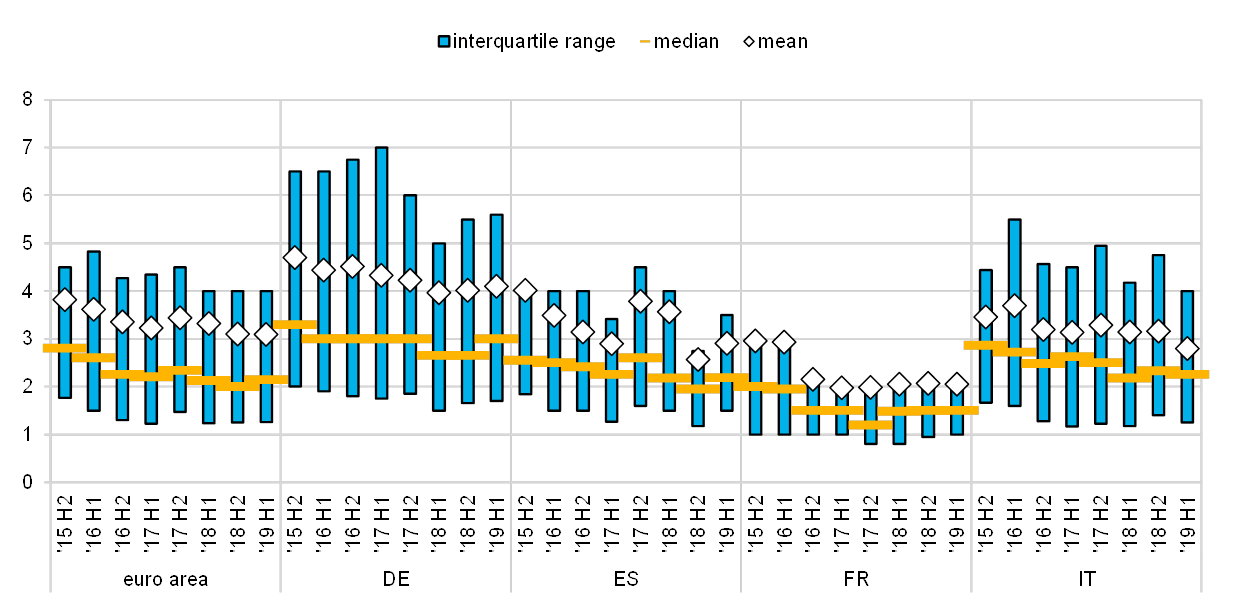
Base: SMEs that had successfully applied for a credit line or bank overdraft or that did not apply because the cost was too high. Figures refer to rounds 14 (October 2015-March 2016) to 21 (April-September 2019) of the survey.Notes: the interquartile range is defined as the difference between the 75th percentile and the 25th percentile. The figures are based on the question introduced in round 11 (April-September 2014).
Q8B. What interest rate was charged for the credit line or bank overdraft for which you applied?
About 48% of the SMEs interviewed indicated that bank loans are not a relevant source of finance for them. In the vast majority of these cases, SMEs had no need for financing via bank loan (76%; see Chart 25). A small percentage pointed to high interest rates or price as the primary reason for not using bank loans (7%, from 6%). The percentage has increased since the last round in Portugal (20%) and Greece (27%) (from 14% and 25%, respectively ), while it has somewhat decreased in some of the remaining countries. In addition, a lack of available bank loans is still a notable factor for Greek SMEs (14%, from 13%).
Reasons why bank loans are not a relevant source of financing for euro area SMEs
(over the preceding six months; percentages of respondents)
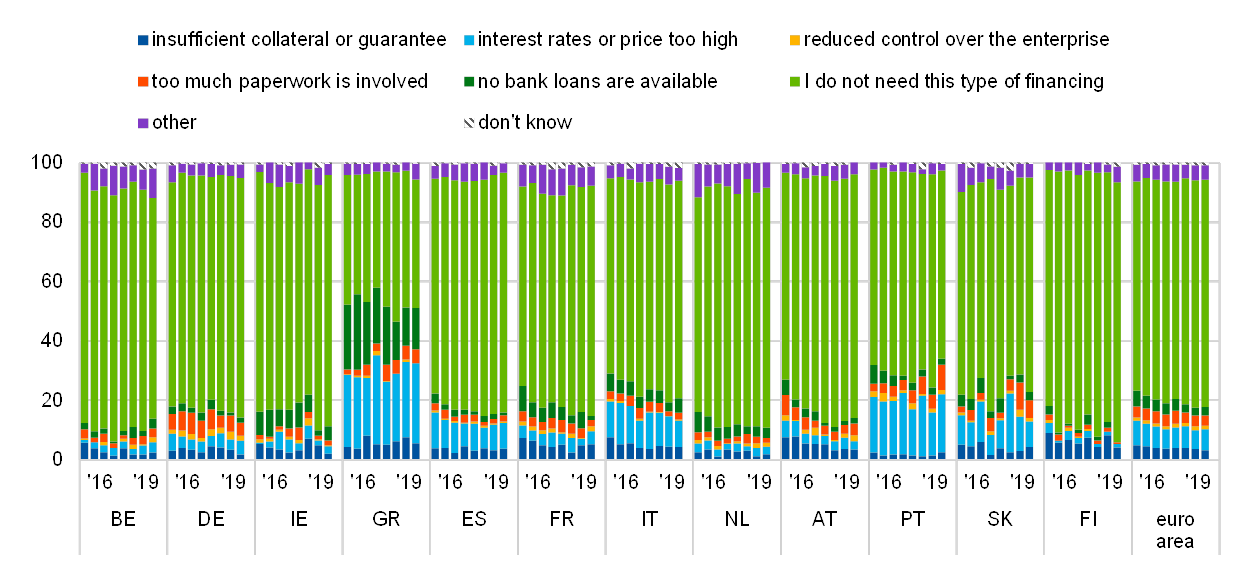
Base: SMEs for which bank loans are not a relevant source of financing. Figures refer to rounds 14 (October 2015-March 2016) to 21 (April-September 2019) of the survey.
Q32. You mentioned that bank loans are not relevant for your enterprise. What is the main reason for this?
5 Expectations regarding access to finance
5.1 SMEs expect further moderate improvements in access to external financing
For the period from October 2019 to March 2020, SMEs are expecting moderate improvements in the availability of external financing sources (see Chart 26). Specifically, a net 4% of SMEs anticipated better access to bank loans, which nevertheless reflects a slight decline from the net 5% reported in the previous survey round. Expectations are similar for the availability of most other external funding instruments, including credit lines (3%, from 4%), other loans (2%, from 4%), leasing and hire-purchase (9%, from 11%), and trade credit (2%, from 9%). This survey round however continued to signal moderate expected improvements in debt securities issuance by SMEs (10%, from 6%) and in equity issuance (12%, from 9%). As usual, these figures need to be treated with some caution, as the percentage of firms answering this question in the survey remains extremely low (only 13% of all SMEs considered market-based financing potentially relevant).
Change in euro area enterprises’ expectations regarding the availability of financing
(over the preceding six months and over the next six months; net percentages of respondents)
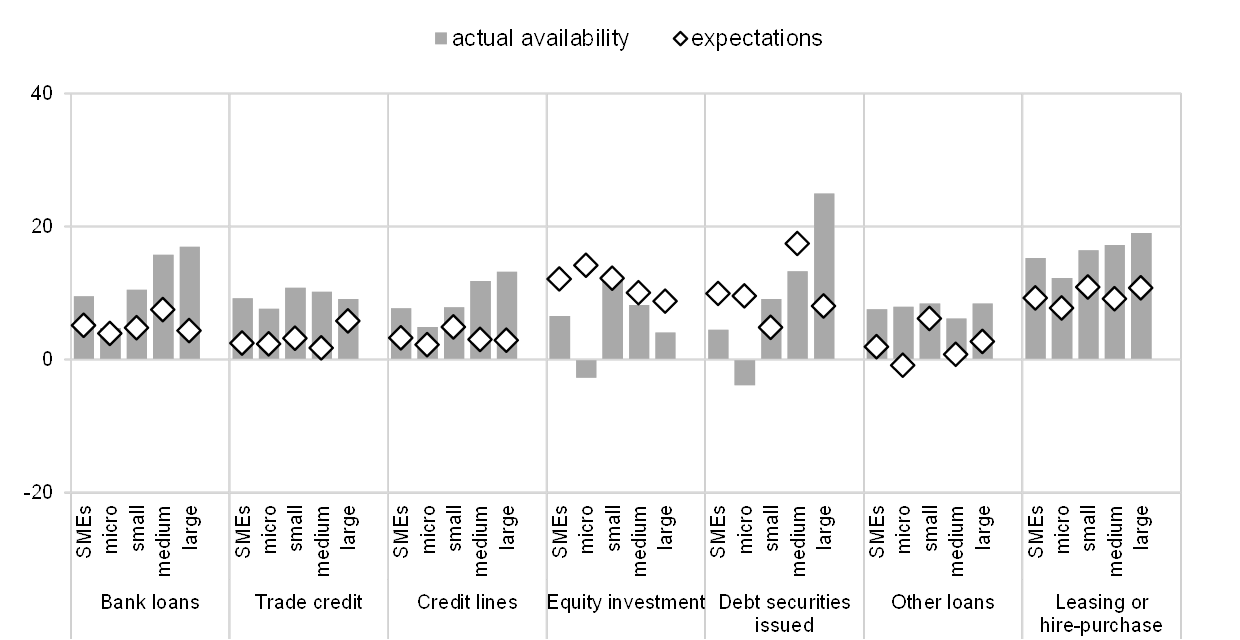
Base: Enterprises for which the respective instrument is relevant. Figures refer to round 21 (April-September 2019) of the survey.Note: see the notes to Charts 1 and 11.
Q9. For each of the following types of financing, would you say that their availability has improved, remained unchanged or deteriorated for your enterprise over the past six months?Q23. Looking ahead, for each of the following types of financing available to your enterprise, please indicate whether you think their availability will improve, deteriorate or remain unchanged over the next six months.
Across different company sizes, large enterprises were more cautious in their expectations for most sources of external financing. In particular, the net percentage of large firms expecting improvements continued to be generally much lower than the net percentage of those reporting actual improvements for bank-related products – bank loans (8%, compared with 17%), credit lines (3%, compared with 13%) and leasing or hire-purchase (11% compared with 19%) – even though they had benefited most from improvements in external financing. This was also the case for other sources of external funds, except equity investment (9%, compared with 4%).
The moderate assessment about further improvements in access to external financing was widespread across the largest euro area countries (see Chart 27). On balance, German SMEs expect no change in the availability of bank loans in the next six months (0%, compared with 11% reporting increased actual availability) while French and Italian SMEs foresee an increase (8% and 9%, respectively). By contrast, for the first time since 2012, Spanish SMEs expect a deterioration (-1%) in the availability of both bank loans and credit lines (see Chart 27).
Change in euro area SMEs’ expectations regarding the availability of financing
(over the preceding six months and over the next six months; net percentages of respondents)
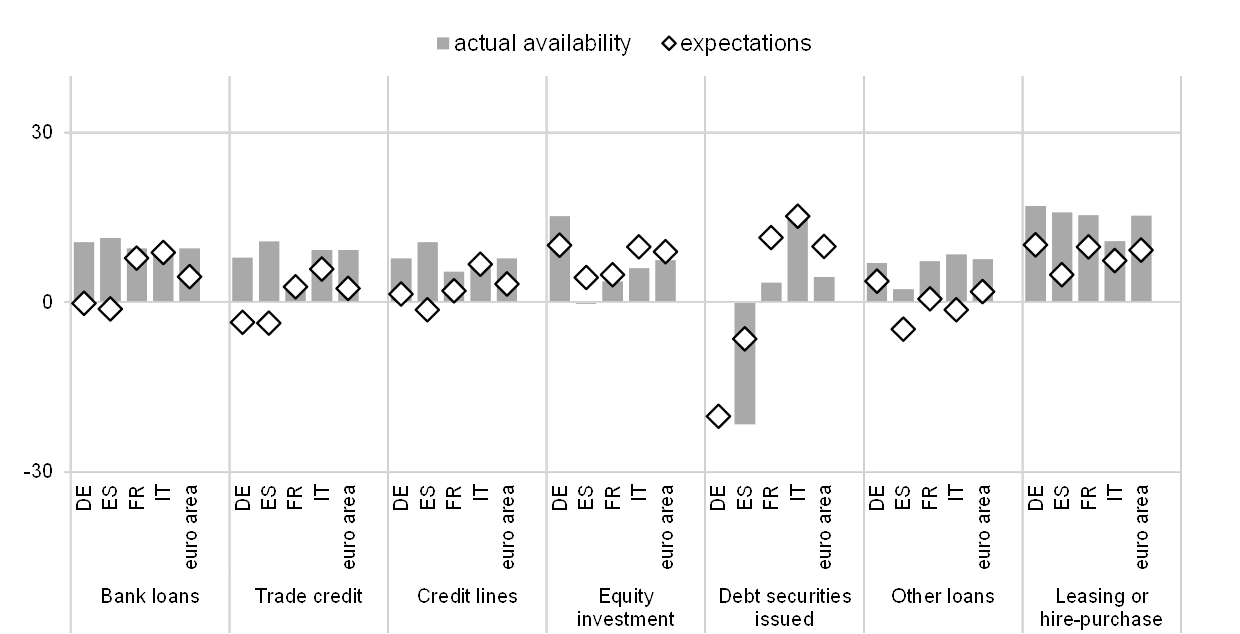
Base: SMEs for which the respective instrument is relevant. Figures refer to round 21 (April-September 2019) of the survey.Note: see the notes to Charts 1 and 11.
Q9. For each of the following types of financing, would you say that their availability has improved, remained unchanged or deteriorated for your enterprise over the past six months?Q23. Looking ahead, for each of the following types of financing available to your enterprise, please indicate whether you think their availability will improve, deteriorate or remain unchanged over the next six months.
Annexes
Annex 1 Overview of the survey replies – selected charts
Change in turnover and profits of SMEs across euro area countries
(over the preceding six months; net percentages of respondents)
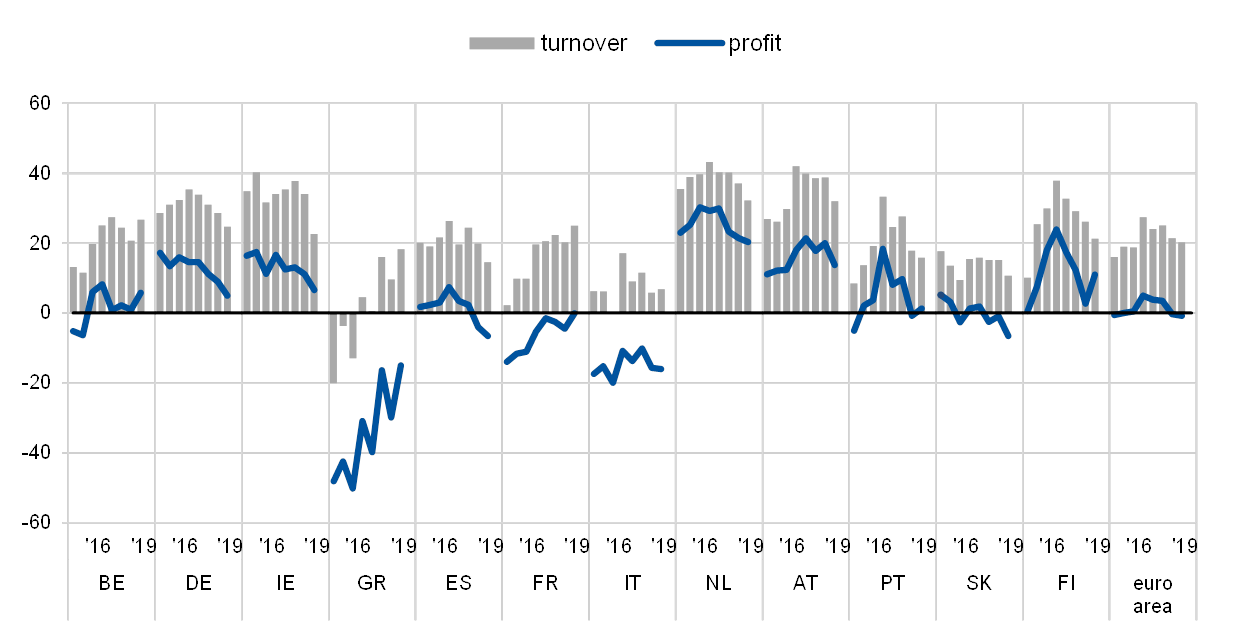
Base: All SMEs. Figures refer to rounds 14 (October 2015-March 2016) to 21 (April-September 2019) of the survey.Note: see the notes to Chart 1.
Q2. Have the following company indicators decreased, remained unchanged or increased over the past six months?
Change in debt-to-total-assets ratio and interest expenses of SMEs across euro area countries
(over the preceding six months; net percentages of respondents)
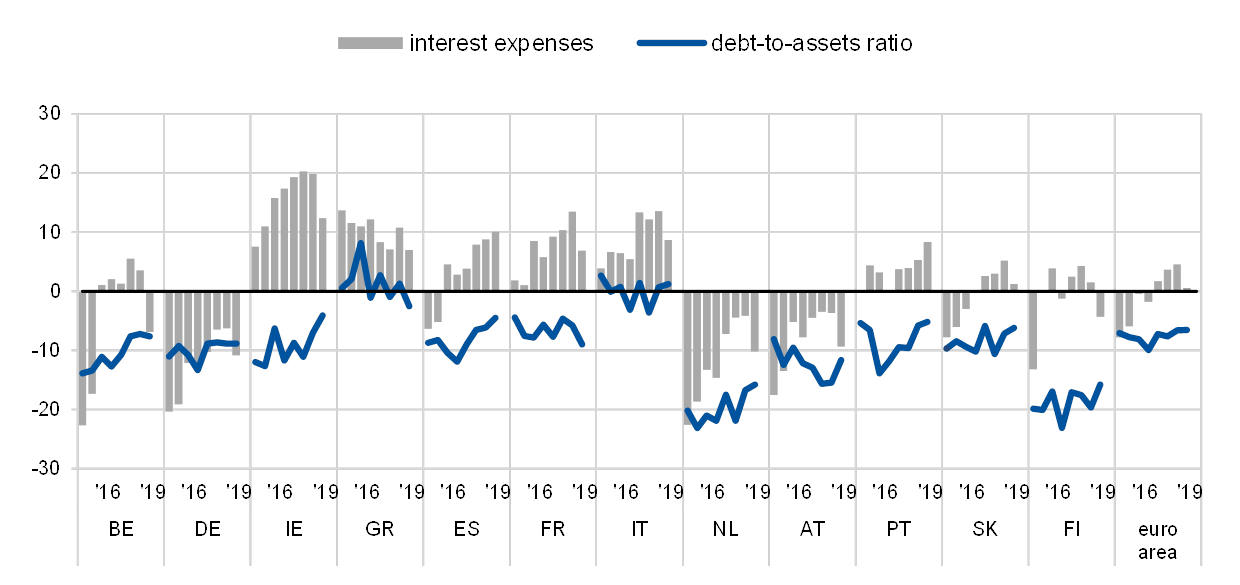
Base: All SMEs. Figures refer to rounds 14 (October 2015-March 2016) to 21 (April-September 2019) of the survey.Note: see the notes to Chart 1.
Q2. Have the following company indicators decreased, remained unchanged or increased over the past six months?
Vulnerable and profitable SMEs across euro area countries
(over the preceding six months; percentages of respondents)
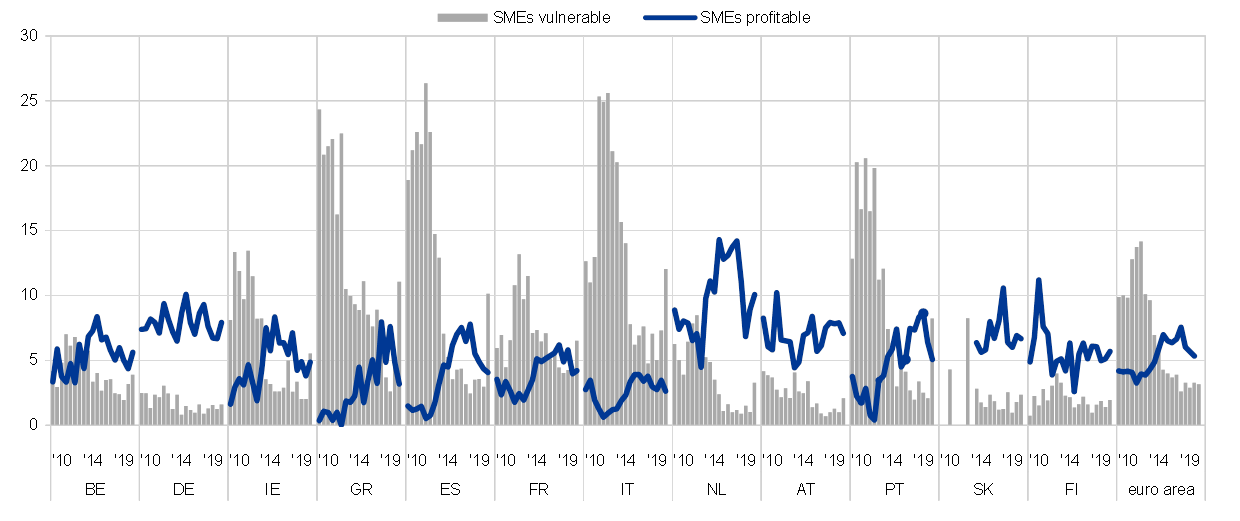
Base: All SMEs. Figures refer to rounds 3 (March-September 2010) to 21 (April-September 2019) of the survey.Note: for definitions, see footnote 8 of the report. In Slovakia, the survey was initially conducted every two years (first half of 2009, 2011 and 2013). From 2014 onwards, Slovakia has been included in the sample in each survey round.
Q2. Have the following company indicators decreased, remained unchanged or increased over the past six months?
The most important problems faced by euro area SMEs across euro area countries
(over the preceding six months; percentages of respondents)
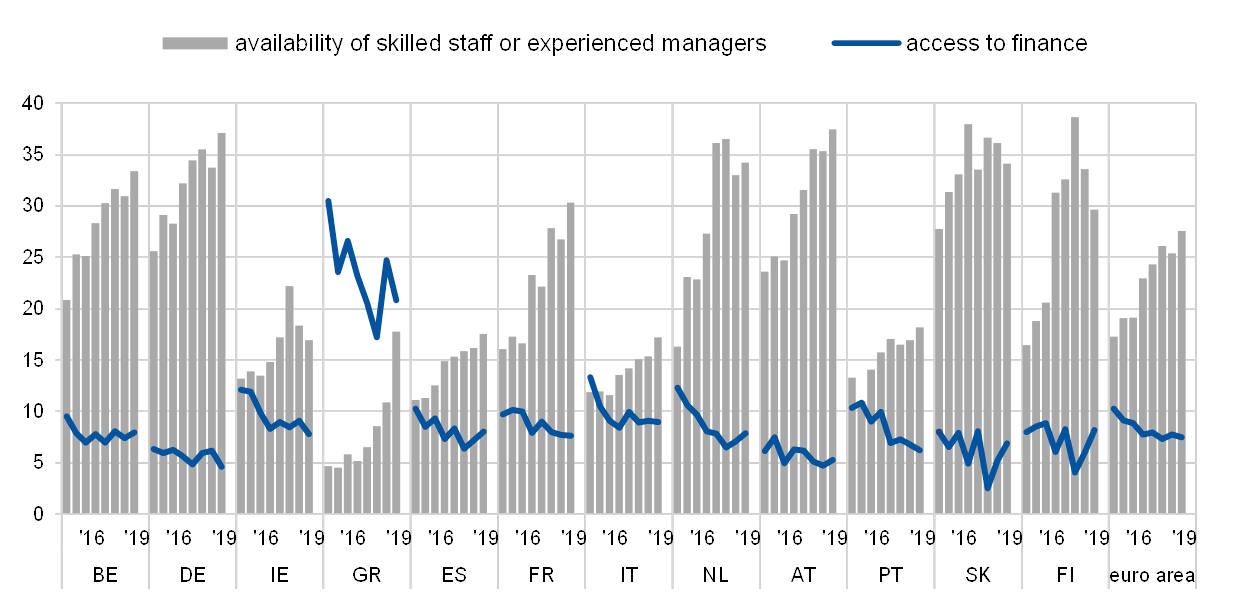
Base: All SMEs. Figures refer to rounds 14 (October 2015-March 2016) to 21 (April-September 2019) of the survey.Note: see the notes to Chart 5.
Q0. How important have the following problems been for your enterprise in the past six months?
Change in the availability of and need for bank loans for SMEs across euro area countries
(over the preceding six months; net percentages of respondents)
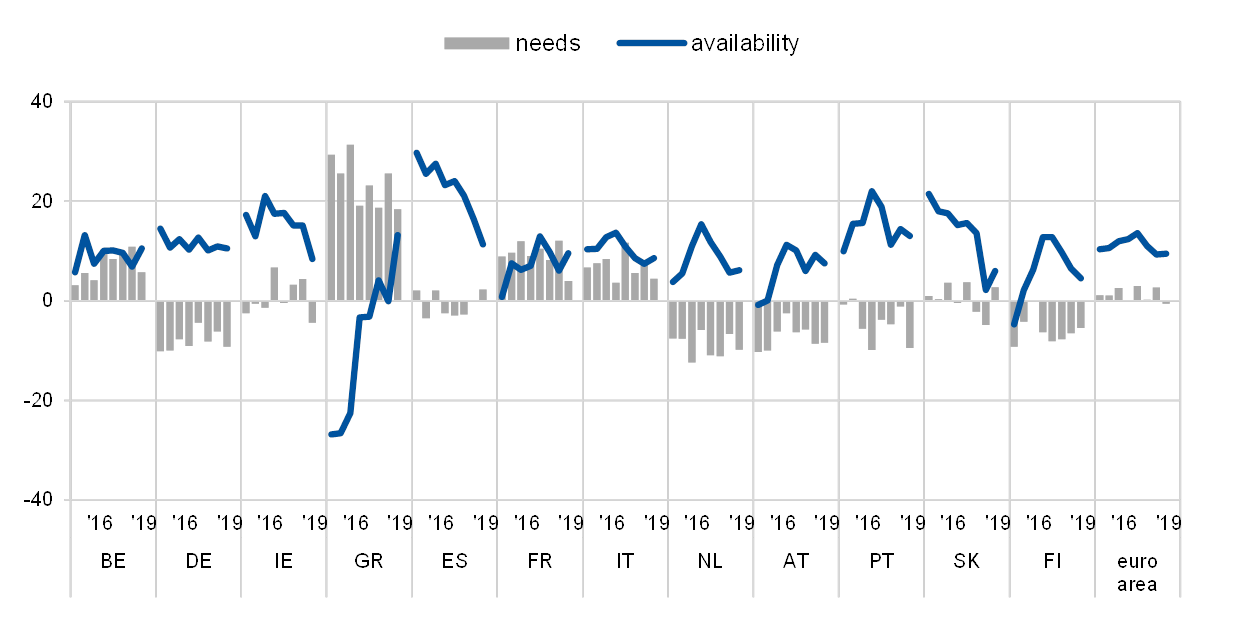
Base: SMEs for which the respective instrument is relevant. Figures refer to rounds 14 (October 2015-March 2016) to 21 (April-September 2019) of the survey.Note: see the notes to Charts 1 and 11.
Q5. For each of the following types of external financing, please indicate if your needs increased, remained unchanged or decreased over the past six months.Q9. For each of the following types of financing, would you say that their availability has improved, remained unchanged or deteriorated for your enterprise over the past six months?
Change in the external financing gap perceived by SMEs across euro area countries
(over the preceding six months; weighted net balances)
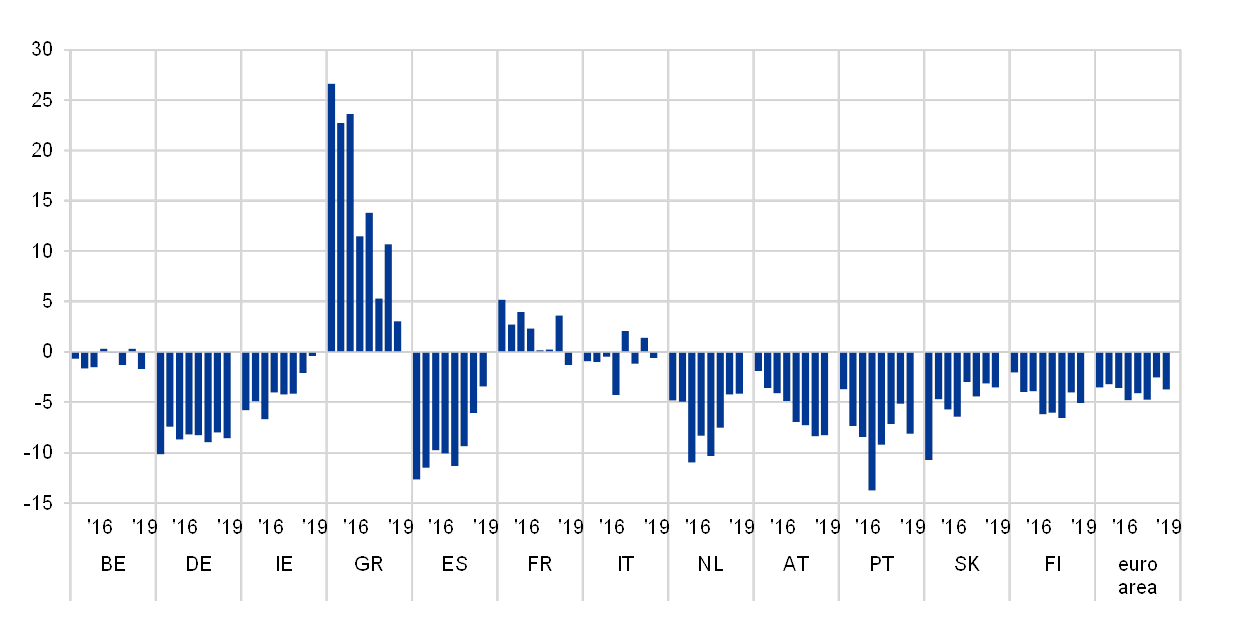
Base: SMEs for which the respective instrument is relevant. “Not applicable” and “Don’t know” answers are excluded. Figures refer to rounds 14 (October 2015-March 2016) to 21 (April-September 2019) of the survey.Note: see notes to Chart 17. The financing gap indicator combines both financing needs and availability of bank loans, credit lines, trade credit, equity and debt securities at the firm level. For each of the five financing instruments, the indicator of the perceived change in the financing gap takes the value of 1 (-1) if the need increases (decreases) and availability decreases (increases). If enterprises perceive only a one-sided increase (decrease) in the financing gap, the variable is assigned a value of 0.5 (-0.5). The composite indicator is the weighted average of the financing gap related to the five instruments. A positive value of the indicator suggests an increasing financing gap. Values are multiplied by 100 to obtain weighted net balances in percentages.
Q5. For each of the following types of external financing, please indicate if your needs increased, remained unchanged or decreased over the past six months.Q9. For each of the following types of financing, would you say that their availability has improved, remained unchanged or deteriorated for your enterprise over the past six months?
Change in factors with an impact on the availability of external financing for SMEs across euro area countries
(over the preceding six months; net percentages of respondents)
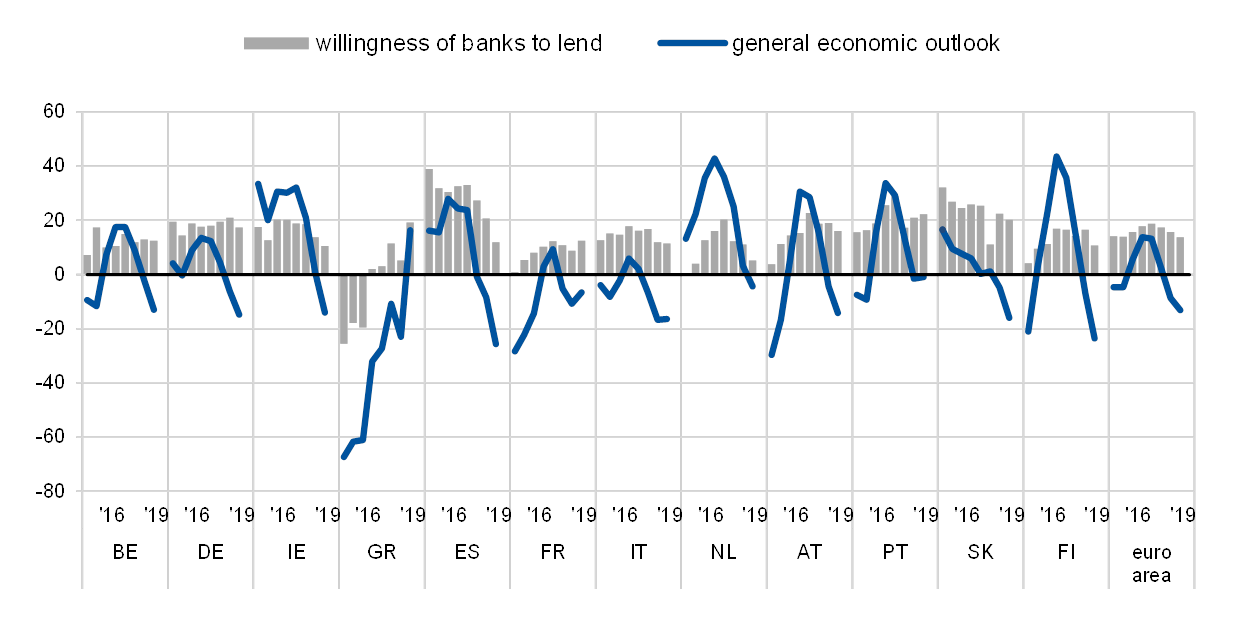
Base: All SMEs. For the category “Willingness of banks to lend”, these are SMEs for which at least one bank financing instrument (credit line, bank overdraft, credit card overdraft, bank loan or subsidised bank loan) is relevant. Figures refer to rounds 14 (October 2015-March 2016) to 21 (April-September 2019) of the survey.Note: see the notes to Charts 1 and 18. From round eleven (April-September 2014), the category “Willingness of banks to provide a loan” was reformulated slightly to “Willingness of banks to provide credit to your enterprise”.
Q11. For each of the following factors, would you say that they have improved, remained unchanged or deteriorated over the past six months?
Applications for bank loans by SMEs across euro area countries
(over the preceding six months; percentages of respondents)
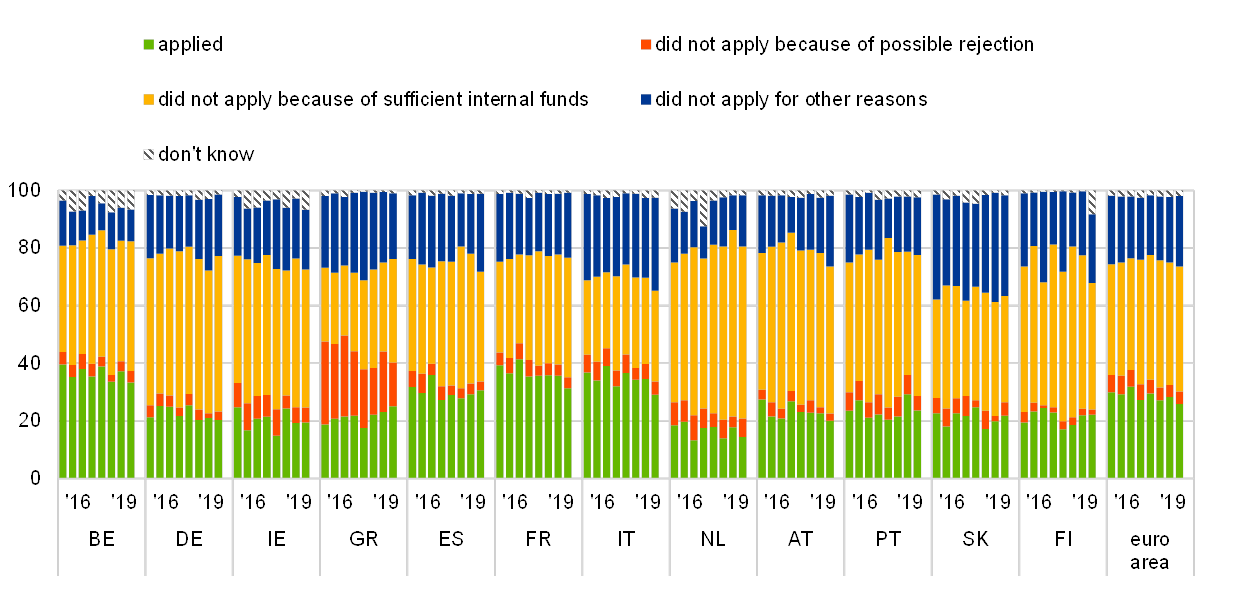
Base: SMEs for which bank loans (including subsided bank loans) are relevant. Figures refer to rounds 14 (October 2015-March 2016) to 21 (April-September 2019) of the survey.Note: see the notes to Chart 11.
Q7A. Have you applied for the following types of financing in the past six months?
Outcome of applications for bank loans by SMEs across euro area countries
(over the preceding six months; percentages of respondents)
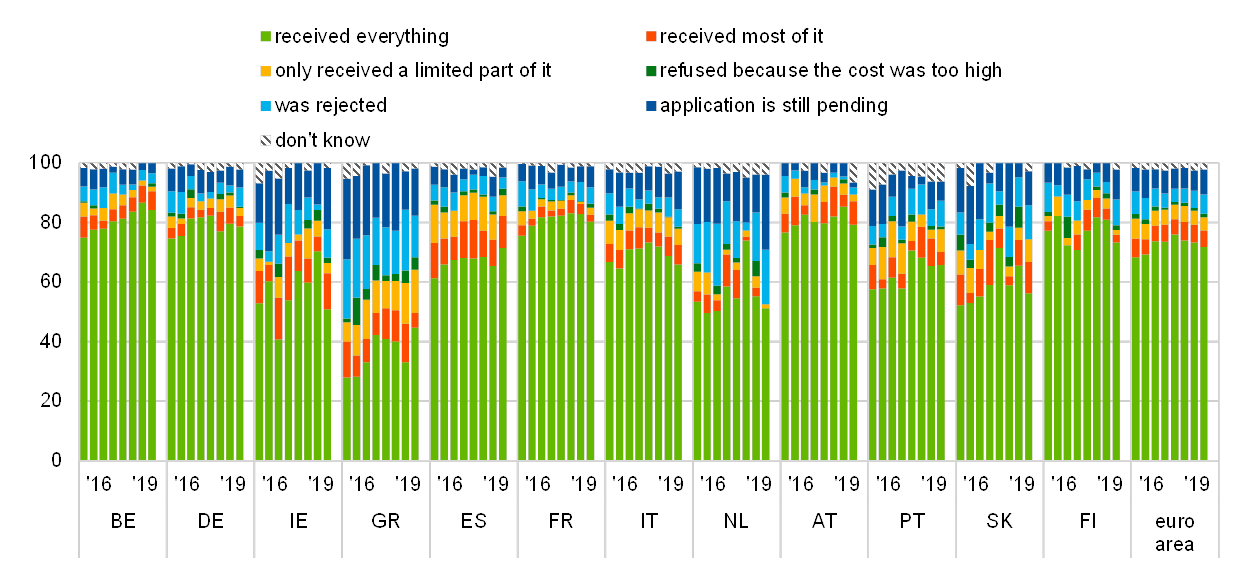
Base: SMEs that had applied for bank loans (including subsided bank loans). Figures refer to rounds 14 (October 2015-March 2016) to 21 (April-September 2019) of the survey.Note: see the notes to Chart 11.
Q7B. If you applied and tried to negotiate this type of financing over the past six months, what was the outcome?
Change in the cost of bank financing for SMEs across euro area countries
(over the preceding six months; net percentages of respondents)
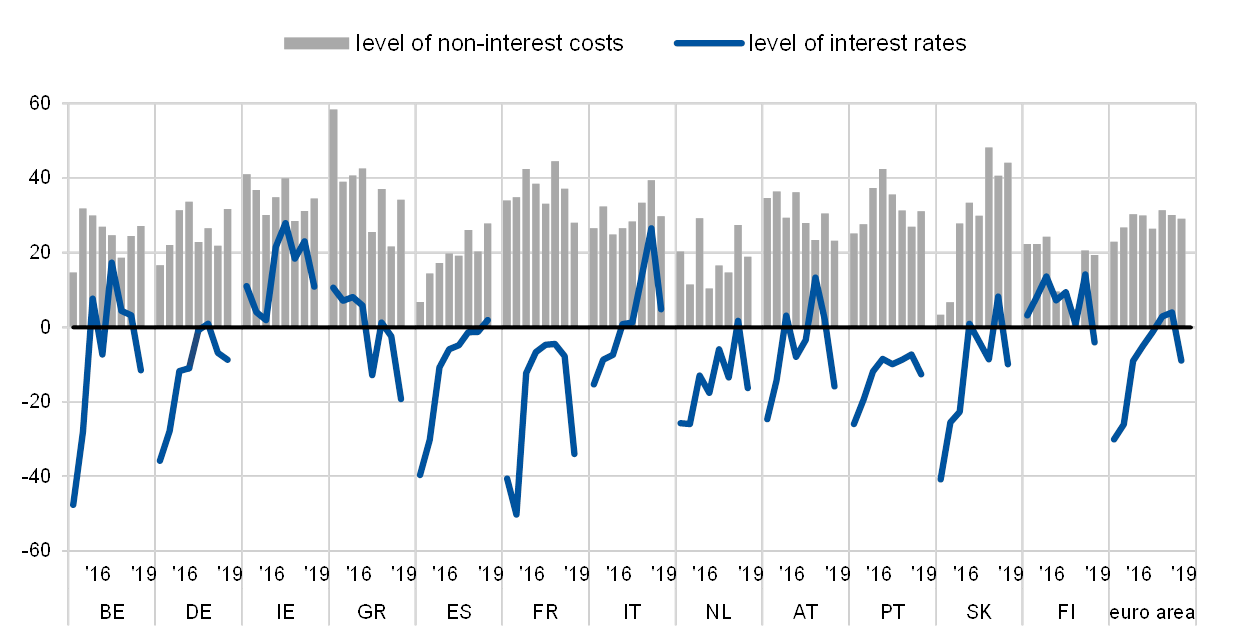
Base: SMEs that had applied for bank loans (including subsidised bank loans), credit lines, or bank or credit card overdrafts. Figures refer to rounds fourteen (October 2015-March 2016) to twenty-one (April-September 2019) of the survey.Note: see the notes to Chart 1.
Q10. Please indicate whether the following items increased, remained unchanged or decreased in the past six months.
Change in non-price terms and conditions of bank financing for SMEs across euro area countries
(over the preceding six months; net percentages of respondents)
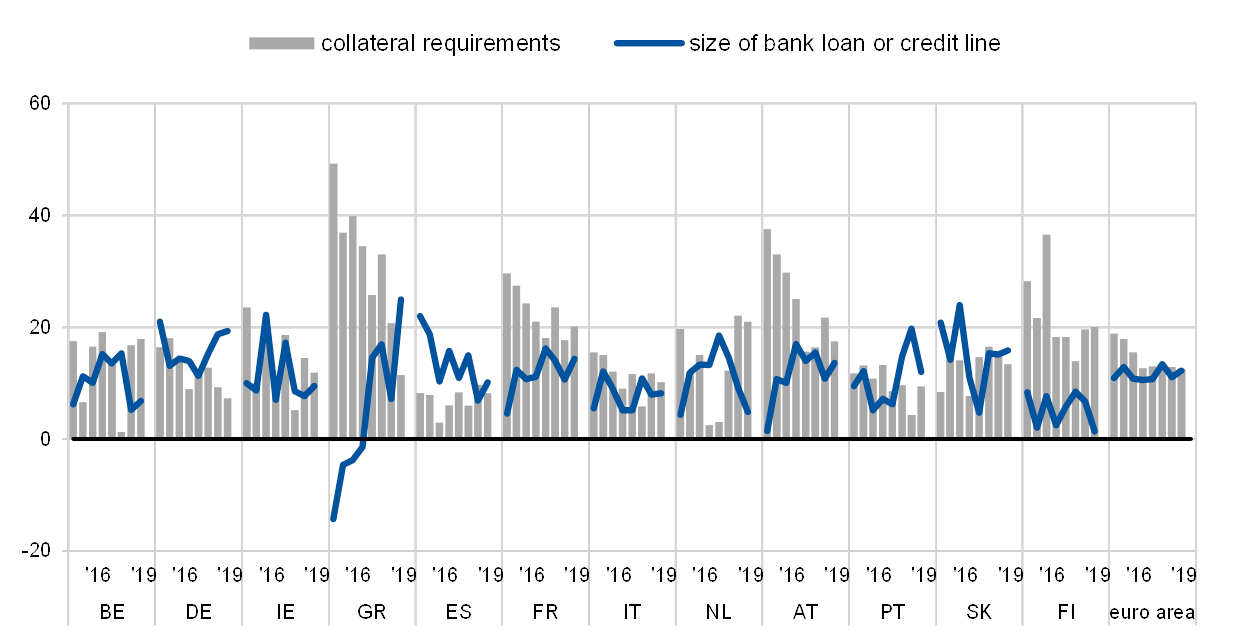
Base: SMEs that had applied for bank loans (including subsidised bank loans), credit lines, or bank or credit card overdrafts. Figures refer to rounds 14 (October 2015-March 2016) to 21 (April-September 2019) of the survey.Note: see the notes to Chart 1.
Q10. Please indicate whether the following items increased, remained unchanged or decreased in the past six months.
Annex 2 Descriptive statistics for the sample of enterprises
Breakdown of enterprises by economic activity
(unweighted percentages)
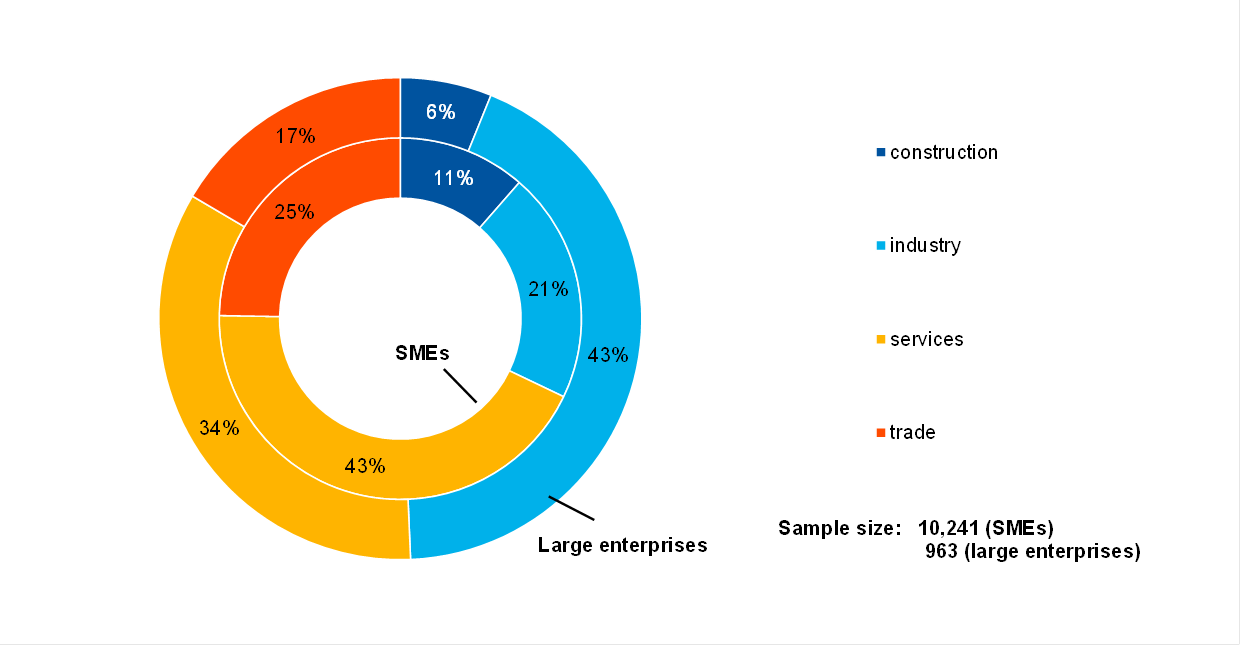
Base: Figures refer to round 21 (April-September 2019) of the survey.
Breakdown of enterprises by age
(unweighted percentages)
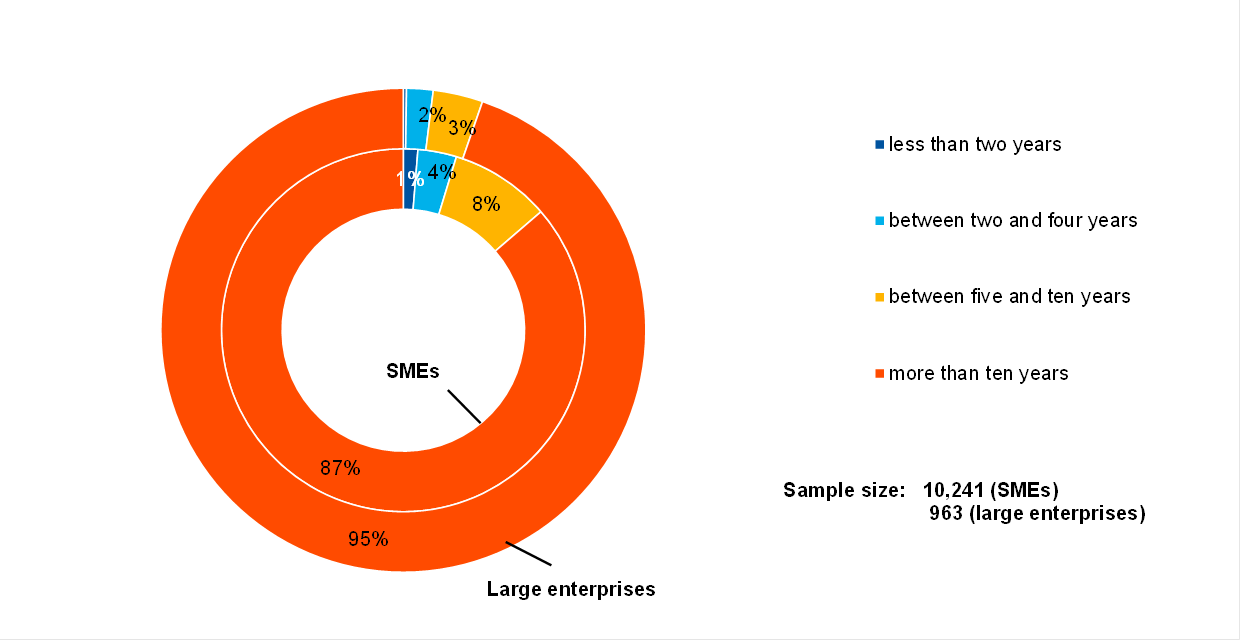
Base: Figures refer to round 21 (April-September 2019) of the survey.
Breakdown of enterprises by ownership
(unweighted percentages)
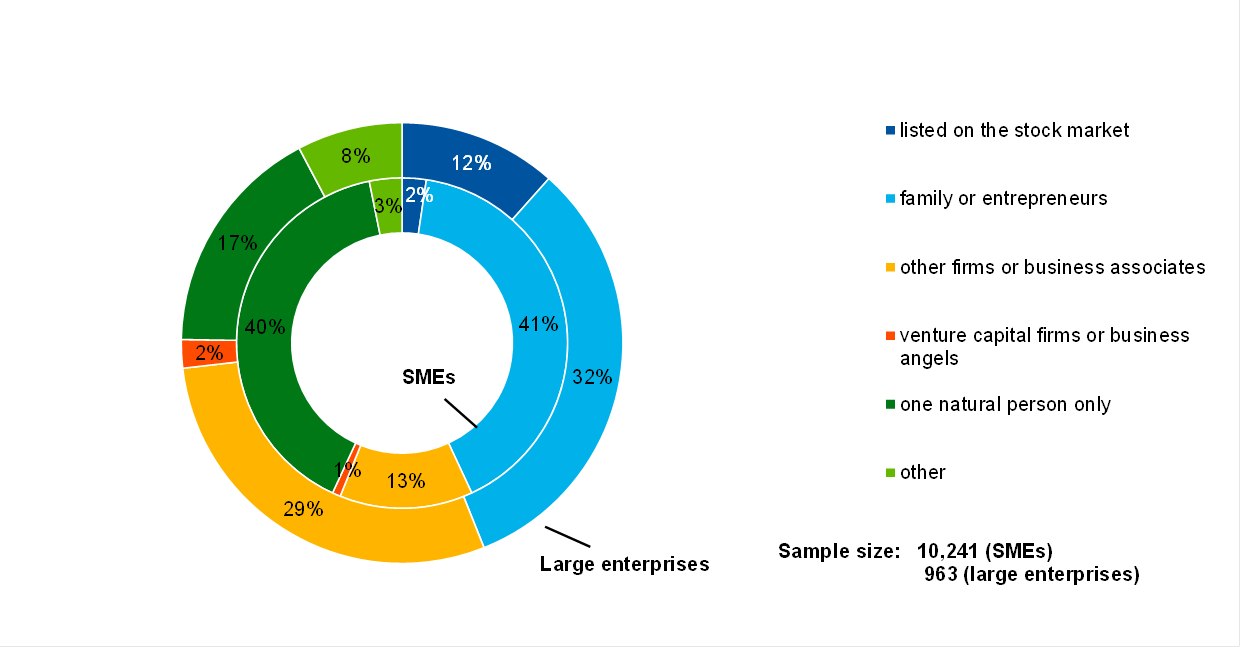
Base: Figures refer to round 21 (April-September 2019) of the survey.
Breakdown of enterprises by exports
(unweighted percentages)
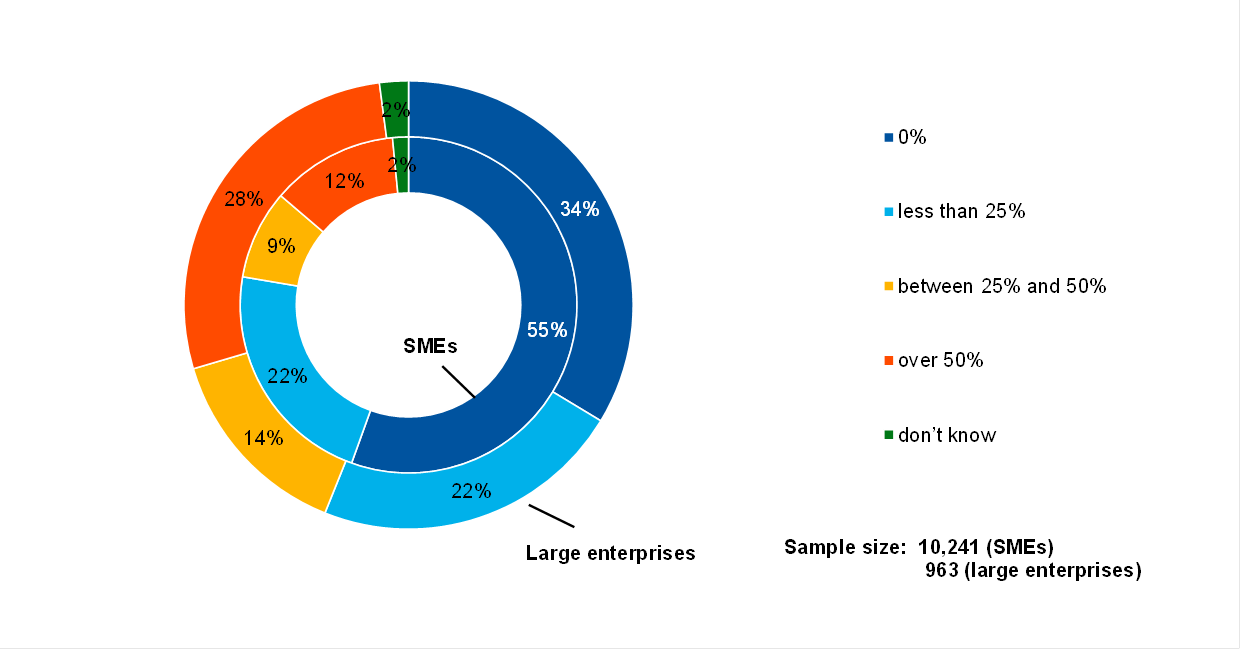
Base: Figures refer to round 21 (April-September 2019) of the survey.
Annex 3 Methodological information on the survey
This annex presents the main changes introduced in the latest round of the Survey on the Access to Finance of Enterprises (SAFE). For an overview of how the survey was set up, the general characteristics of the euro area enterprises that participated in the survey and the changes introduced to the methodology and the questionnaire over time, see the “Methodological information on the survey and user guide for the anonymised micro dataset” available on the ECB’s website.[15]
Since September 2014 the survey has been carried out by Panteia b.v., in cooperation with the fieldwork provider GDCC. To the best of our knowledge, no breaks in the series are attributable to any change of provider over the life cycle of the survey.
However, some changes in the questionnaire may have caused a break between the round covering the second half of 2013 and that covering the first half of 2014. This stems from the review of various components of the survey after ten survey rounds, covering the questionnaire, sample allocation, survey mode and weighting scheme (see Annex 4 in the corresponding report on the ECB’s website for details[16]).
With regard to the weighting scheme, up to the survey round in the first half of 2015, the calibration targets were updated with each survey round based on the latest available figures from Eurostat’s structural business statistics (SBS). Since then, with all the euro area countries participating in the survey, the weighting scheme has been updated once a year.[17]
In this survey round no major changes were made to the existing questions in the questionnaire.[18]
© European Central Bank, 2019
Postal address 60640 Frankfurt am Main, GermanyTelephone +49 69 1344 0Website www.ecb.europa.eu
All rights reserved. Reproduction for educational and non-commercial purposes is permitted provided that the source is acknowledged.The cut-off date for data included in this report was 28 November 2019.
PDF ISSN 1831-9998, QB-AP-19-002-EN-NHTML ISSN 1831-9998, QB-AP-19-002-EN-Q
- [1]See Annex 3 for details on methodological issues related to the survey set-up.
- [2]Net terms or net percentages are defined as the difference between the percentage of enterprises reporting that a given factor has increased and the percentage of those reporting that it has declined.
- [3]A negative financing gap indicates that the increase in the need for external financing is smaller than the improvement in the access to external funds.
- [4]The financing obstacles indicator is the sum of the percentages of SMEs reporting rejections of loan applications, loan applications for which only a limited amount was granted, and loan applications which resulted in an offer that was declined by the SME because the borrowing costs were too high, as well as the percentage of SMEs that did not apply for a loan for fear of rejection.
- [5]Net terms or net percentages are defined as the difference between the percentage of enterprises reporting that a given factor had increased and the percentage reporting that it had declined.
- [6]Micro enterprises are enterprises with 1-9 employees, small enterprises are those with 10-49 employees, medium-sized enterprises have 50-249 employees and large enterprises have 250 or more employees. The term “small and medium-sized enterprises” (SMEs) covers micro, small and medium-sized enterprises.
- [7]The reference period for the previous survey round was October 2018 to March 2019.
- [8]See the box entitled “Distressed and profitable firms: two new indicators on the financial position of enterprises”, Survey on the Access to Finance of Enterprises in the euro area – October 2017 to March 2018. Vulnerable firms are defined as those firms that have simultaneously reported lower turnover, decreasing profits, higher interest expenses and a higher or unchanged debt-to-assets ratio. At the other end of the spectrum, profitable firms are those that simultaneously report higher turnover and profits, lower or no interest expenses and a lower or no debt-to-assets ratio.
- [9]A late payment is defined as a payment not made within the contractual or statutory period of payment, unless the debtor is not responsible for the delay, and when the creditor has fulfilled all its legal and contractual obligations.
- [10]The formulation of the question allows the relevance of a specific financial instrument to be disentangled from its usage. See the SAFE questionnaire.
- [11]See footnote 8 of the report.
- [12]See the note to Chart 11. Only survey respondents who report that a particular financing instrument is relevant for their enterprise are asked about their need for that source of financing.
- [13]See the notes to Chart 11. Only survey respondents that report that a particular financing instrument (i.e. bank loans, credit lines, trade credit, leasing and hire-purchase or other loans) is relevant for their enterprise are asked about the availability of these sources of financing.
- [14]From round 11 (April-September 2014), the question regarding the interest rate of the credit line or bank overdraft was added to the questionnaire. The weighted mean reported by euro area enterprises (2.3%) is 18 basis points higher than the official monetary financial institutions’ interest rate statistics on bank overdrafts (average in the period from April-September 2019), while the median value (1.6%) is 54 basis points lower. Some caveats apply when comparing the figures quoted in this report with the official bank interest rate statistics: (i) the bank statistics are weighted by the loan volumes, while the survey responses are weighted by the number of employees; and (ii) the bank statistics refer to the full financing granted in the period, while the survey includes all enterprises that had successfully applied for the credit line or bank overdraft or did not apply because the cost was too high.
- [15]Survey on the access to finance of enterprises – Methodological information on the survey and user guide for the anonymised micro dataset
- [16]Survey on the Access to Finance of Enterprises in the euro area – April 2014 to September 2014
- [17]For more details, see the section on weighting in “Survey on the access to finance of enterprises – Methodological information on the survey and user guide for the anonymised micro dataset”.
- [18]The questionnaire is available on the ECB’s website. It was translated into the respective languages for the purposes of the survey.
-
29 November 2019


